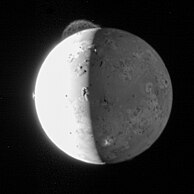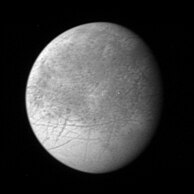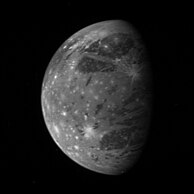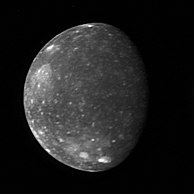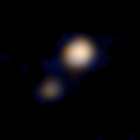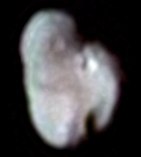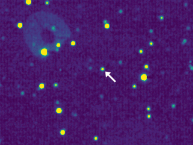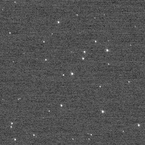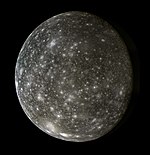New Horizons
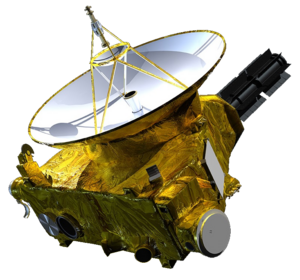 New Horizonsspace probe | |||||||||||||||||
| Mission type | Flyby (132524 APL·Jupiter·Pluto·486958 Arrokoth) | ||||||||||||||||
|---|---|---|---|---|---|---|---|---|---|---|---|---|---|---|---|---|---|
| Operator | NASA | ||||||||||||||||
| COSPAR ID | 2006-001A | ||||||||||||||||
| SATCATno. | 28928 | ||||||||||||||||
| Website | pluto science.nasa.gov/mission/new-horizons | ||||||||||||||||
| Mission duration | Primary mission: 9.5 years Elapsed: 18 years, 5 months, 26 days | ||||||||||||||||
| Spacecraft properties | |||||||||||||||||
| Manufacturer | APL/SwRI | ||||||||||||||||
| Launch mass | 478 kg (1,054 lb)[1] | ||||||||||||||||
| Dry mass | 401 kg (884 lb) | ||||||||||||||||
| Payload mass | 30.4 kg (67 lb) | ||||||||||||||||
| Dimensions | 2.2 × 2.1 × 2.7 m (7.2 × 6.9 × 8.9 ft) | ||||||||||||||||
| Power | 245 watts | ||||||||||||||||
| Start of mission | |||||||||||||||||
| Launch date | January 19, 2006, 19:00:00.221UTC[2] | ||||||||||||||||
| Rocket | Atlas V(551) AV-010[2]+Star 48B 3rd stage | ||||||||||||||||
| Launch site | Cape CanaveralSLC-41 | ||||||||||||||||
| Contractor | International Launch Services[3] | ||||||||||||||||
| Orbital parameters | |||||||||||||||||
| Eccentricity | 1.41905 | ||||||||||||||||
| Inclination | 2.23014° | ||||||||||||||||
| Epoch | January 1, 2017 (JD2457754.5)[4] | ||||||||||||||||
| Flyby of132524 APL(incidental) | |||||||||||||||||
| Closest approach | June 13, 2006, 04:05 UTC | ||||||||||||||||
| Distance | 101,867 km (63,297 mi) | ||||||||||||||||
| Flyby ofJupiter(gravity assist) | |||||||||||||||||
| Closest approach | February 28, 2007, 05:43:40 UTC | ||||||||||||||||
| Distance | 2,300,000 km (1,400,000 mi) | ||||||||||||||||
| Flyby ofPluto | |||||||||||||||||
| Closest approach | July 14, 2015, 11:49:57 UTC | ||||||||||||||||
| Distance | 12,500 km (7,800 mi) | ||||||||||||||||
| Flyby ofCharon (moon) | |||||||||||||||||
| Closest approach | July 14, 2015, 12:02:22 UTC | ||||||||||||||||
| Distance | 29,431 km (18,288 mi) | ||||||||||||||||
| Flyby of486958 Arrokoth | |||||||||||||||||
| Closest approach | January 1, 2019, 05:33:00 UTC | ||||||||||||||||
| Distance | 3,500 km (2,200 mi) | ||||||||||||||||
| |||||||||||||||||

| |||||||||||||||||
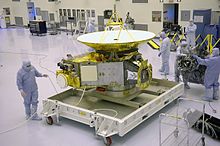
New Horizonsis aninterplanetary space probelaunched as a part ofNASA'sNew Frontiers program.[5]Engineered by the Johns Hopkins UniversityApplied Physics Laboratory(APL) and theSouthwest Research Institute(SwRI), with a team led byAlan Stern,[6]the spacecraft was launched in 2006 with the primary mission to perform aflybystudy of thePlutosystem in 2015, and a secondary mission to fly by and study one or more otherKuiper beltobjects (KBOs) in the decade to follow, which became a mission to486958 Arrokoth.It is thefifth space probeto achieve theescape velocityneeded to leave theSolar System.
On January 19, 2006,New Horizonswas launched fromCape Canaveral Air Force Stationby anAtlas Vrocketdirectly into an Earth-and-solarescape trajectorywith a speed of about 16.26 km/s (10.10 mi/s; 58,500 km/h; 36,400 mph). It was the fastest (average speed with respect to Earth) human-made object ever launched from Earth.[7][8][9][10]It is not the fastest speed recorded for a spacecraft, which, as of 2023, is that of theParker Solar Probe.After a brief encounter withasteroid132524 APL,New Horizonsproceeded toJupiter,making its closest approach on February 28, 2007, at a distance of 2.3 million kilometers (1.4 million miles). The Jupiter flyby provided agravity assistthat increasedNew Horizons'speed; the flyby also enabled a general test ofNew Horizons'scientific capabilities, returning data aboutthe planet's atmosphere,moons,andmagnetosphere.
Most of the post-Jupiter voyage was spent inhibernation modeto preserve onboard systems, except for brief annual checkouts.[11]On December 6, 2014,New Horizonswas brought back online for the Pluto encounter, and instrument check-out began.[12]On January 15, 2015, the spacecraft began its approach phase to Pluto.
On July 14, 2015, at 11:49UTC,it flew 12,500 km (7,800 mi) above the surface of Pluto,[13][14]which at the time was 34 AU from the Sun,[15]making it the first spacecraft to explore the dwarf planet.[16]In August 2016,New Horizonswas reported to have traveled at speeds of more than 84,000 km/h (52,000 mph).[17]On October 25, 2016, at 21:48 UTC, the last recorded data from the Pluto flyby was received fromNew Horizons.[18]Having completed its flyby of Pluto,[19]New Horizonsthen maneuvered for a flyby of Kuiper belt object486958 Arrokoth(then nicknamedUltima Thule),[20][21][22]which occurred on January 1, 2019,[23][24]when it was 43.4AU(6.49billionkm;4.03 billionmi) from theSun.[20][21]In August 2018, NASA cited results byAliceonNew Horizonsto confirm the existence of a "hydrogen wall"at theouter edges of the Solar System.This "wall" was first detected in 1992 by the twoVoyager spacecraft.[25][26]
As of July 2024,New Horizonsis traveling through the Kuiper belt; it is 58.3AU(8.72billionkm;5.42 billionmi) from Earth and 59.3AU(8.87billionkm;5.51 billionmi) from the Sun.[27]NASA has announced it is to extend operations forNew Horizonsuntil the spacecraft exits the Kuiper belt, which is expected to occur between 2028 and 2029.[28]
History[edit]

In August 1992,JPLscientist Robert Staehle called Pluto discovererClyde Tombaugh,requesting permission to visit his planet. "I told him he was welcome to it," Tombaugh later remembered, "though he's got to go one long, cold trip."[29]The call eventually led to a series of proposed Pluto missions leading up toNew Horizons.
Stamatios "Tom" Krimigis,head of theApplied Physics Laboratory's space division, one of many entrants in the New Frontiers Program competition, formed theNew Horizonsteam withAlan Sternin December 2000. Appointed as the project'sprincipal investigator,Stern was described by Krimigis as "the personification of the Pluto mission".[30]New Horizonswas based largely on Stern's work sincePluto 350and involved most of the team fromPluto Kuiper Express.[31]
TheNew Horizonsproposal was one of five that were officially submitted to NASA. It was later selected as one of two finalists to be subject to a three-month concept study in June 2001. The other finalist, POSSE (Pluto and Outer Solar System Explorer), was a separate but similar Pluto mission concept by theUniversity of Colorado Boulder,led by principal investigatorLarry W. Esposito,and supported by the JPL,Lockheed Martinand theUniversity of California.[32]
However, the APL, in addition to being supported byPluto Kuiper Expressdevelopers at the Goddard Space Flight Center andStanford University[32]were at an advantage; they had recently developedNEAR Shoemakerfor NASA, which had successfully entered orbit around433 Erosearlier that year, and would later land on the asteroid to scientific and engineering fanfare.[33]
In November 2001,New Horizonswas officially selected for funding as part of the New Frontiers program.[34]However, the new NASA Administrator appointed by theBush administration,Sean O'Keefe,was not supportive ofNew Horizonsand effectively canceled it by not including it in NASA's budget for 2003. NASA's Associate Administrator for the Science Mission Directorate,Ed Weiler,prompted Stern to lobby for the funding ofNew Horizonsin hopes of the mission appearing in thePlanetary Science Decadal Survey,a prioritized "wish list," compiled by theUnited States National Research Council,that reflects the opinions of the scientific community.[30]
After an intense campaign to gain support forNew Horizons,the Planetary Science Decadal Survey of 2003–2013 was published in the summer of 2002.New Horizonstopped the list of projects considered the highest priority among the scientific community in the medium-size category; ahead of missions to the Moon, and even Jupiter. Weiler stated that it was a result that "[his] administration was not going to fight".[30]Funding for the mission was finally secured following the publication of the report. Stern's team was finally able to start building the spacecraft and its instruments, with a planned launch in January 2006 and arrival at Pluto in 2015.[30]Alice Bowmanbecame Mission Operations Manager (MOM).[35]
Mission profile[edit]
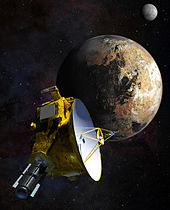
New Horizonsis the first mission in NASA's New Frontiers mission category, larger and more expensive than the Discovery missions but smaller than the missions of the Flagship Program. The cost of the mission, including spacecraft and instrument development, launch vehicle, mission operations, data analysis, and education/public outreach, is approximately $700 million over 15 years (2001–2016).[36]The spacecraft was built primarily bySouthwest Research Institute(SwRI) and theJohns HopkinsApplied Physics Laboratory. The mission's principal investigator isAlan Sternof the Southwest Research Institute (formerly NASA Associate Administrator).
After separation from the launch vehicle, overall control was taken by Mission Operations Center (MOC) at the Applied Physics Laboratory inHoward County, Maryland.The science instruments are operated at Clyde Tombaugh Science Operations Center (T-SOC) inBoulder, Colorado.[37]Navigation is performed at various contractor facilities, whereas the navigational positional data and related celestial reference frames are provided by theNaval Observatory Flagstaff Stationthrough Headquarters NASA andJPL.
KinetXis the lead on theNew Horizonsnavigation team and is responsible for planning trajectory adjustments as the spacecraft speeds towardthe outer Solar System.Coincidentally the Naval Observatory Flagstaff Station was where the photographic plates were taken for the discovery of Pluto's moonCharon.The Naval Observatory itself is not far from theLowell Observatorywhere Pluto was discovered.
New Horizonswas originally planned as a voyage to the only unexplored planet in the Solar System. When the spacecraft was launched, Pluto was still classified as aplanet,later to bereclassifiedas a dwarf planet by theInternational Astronomical Union(IAU). Some members of theNew Horizonsteam, including Alan Stern, disagree with the IAU definition and still describe Pluto as the ninth planet.[38]Pluto's satellitesNixandHydraalso have a connection with the spacecraft: the first letters of their names (N and H) are the initials ofNew Horizons.The moons' discoverers chose these names for this reason, plus Nix and Hydra's relationship to the mythologicalPluto.[39]
In addition to the science equipment, there are several cultural artifacts traveling with the spacecraft. These include a collection of 434,738 names stored on a compact disc,[40]a piece ofScaled Composites'sSpaceShipOne,[41]a "Not Yet Explored" USPS stamp,[42][43]and aFlag of the United States,along with other mementos.[44]
About 30 grams (1 oz) of Clyde Tombaugh's ashes are aboard the spacecraft, to commemorate his discovery of Pluto in 1930.[45][46]A Florida-state quartercoin, whose design commemorates human exploration, is included, officially as a trim weight.[47]One of the science packages (a dust counter) is named afterVenetia Burney,who, as a child, suggested the name "Pluto" after its discovery.
Goal[edit]
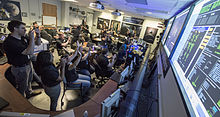
The goal of the mission is to understand the formation of the Plutonian system, the Kuiper belt, and the transformation of the early Solar System.[48]The spacecraft collected data on the atmospheres, surfaces, interiors, and environments of Pluto and its moons. It will also study other objects in the Kuiper belt.[49]"By way of comparison,New Horizonsgathered 5,000 times as much data at Pluto asMarinerdid at theRed Planet."[50]
Some of the questions the mission attempts to answer are: What is Pluto's atmosphere made of and how does it behave? What does its surface look like? Are there large geological structures? How dosolar windparticles interact with Pluto's atmosphere?[51]
Specifically, the mission's science objectives are to:[52]
- Map the surface compositions of Pluto andCharon
- Characterize the geologies and morphologies of Pluto and Charon
- Characterize the neutralatmosphere of Plutoand its escape rate
- Search for an atmosphere around Charon
- Map surface temperatures on Pluto and Charon
- Search for rings and additional satellites around Pluto
- Conduct similar investigations of one or moreKuiper beltobjects
Design and construction[edit]

This sectionneeds additional citations forverification.(July 2020) |
Spacecraft subsystems[edit]

The spacecraft is comparable in size and general shape to agrand pianoand has been compared to a piano glued to a cocktail bar-sized satellite dish.[53]As a point of departure, the team took inspiration from theUlyssesspacecraft,[54]which also carried aradioisotope thermoelectric generator(RTG) and dish on a box-in-box structure through the outer Solar System. Many subsystems and components have flight heritage from APL'sCONTOURspacecraft, which in turn had heritage from APL'sTIMEDspacecraft.
New Horizons'body forms a triangle, almost 0.76 m (2.5 ft) thick. (ThePioneershavehexagonalbodies, whereas theVoyagers,Galileo,andCassini–Huygenshavedecagonal,hollow bodies.) A7075 aluminium alloytube forms the main structural column, between the launch vehicle adapter ring at the "rear", and the 2.1 m (6 ft 11 in) radiodish antennaaffixed to the "front" flat side. Thetitaniumfuel tank is in this tube. The RTG attaches with a 4-sided titanium mount resembling a gray pyramid or stepstool.
Titanium provides strength and thermal isolation. The rest of the triangle is primarily sandwich panels of thin aluminum face sheet (less than1⁄64in or 0.40 mm) bonded to aluminum honeycomb core. The structure is larger than strictly necessary, with empty space inside. The structure is designed to act asshielding,reducing electronicserrors caused by radiationfrom the RTG. Also, the mass distribution required for a spinning spacecraft demands a wider triangle.
The interior structure is painted black to equalize temperature byradiativeheat transfer. Overall, the spacecraft is thoroughly blanketed to retain heat. Unlike thePioneersandVoyagers,the radio dish is also enclosed in blankets that extend to the body. The heat from the RTG adds warmth to the spacecraft while it is in the outer Solar System. While in the inner Solar System, the spacecraft must prevent overheating, hence electronic activity is limited, power is diverted toshuntswith attached radiators, andlouversare opened to radiate excess heat. While the spacecraft is cruising inactively in the cold outer Solar System, the louvers are closed, and the shunt regulator reroutes power to electricheaters.
Propulsion and attitude control[edit]
New Horizonshas both spin-stabilized (cruise) and three-axis stabilized (science) modes controlled entirely withhydrazinemonopropellant.Additional post launchdelta-vof over 290 m/s (1,000 km/h; 650 mph) is provided by a 77 kg (170 lb) internal tank. Helium is used as a pressurant, with anelastomericdiaphragm assisting expulsion. The spacecraft's on-orbit mass including fuel is over 470 kg (1,040 lb) on the Jupiter flyby trajectory, but would have been only 445 kg (981 lb) for the backup direct flight option to Pluto. Significantly, had the backup option been taken, this would have meant less fuel for later Kuiper belt operations.
There are 16thrustersonNew Horizons:four 4.4N(1.0lbf) and twelve 0.9 N (0.2 lbf) plumbed into redundant branches. The larger thrusters are used primarily for trajectory corrections, and the small ones (previously used onCassiniand theVoyagerspacecraft) are used primarily forattitude controland spinup/spindown maneuvers. Two star cameras are used to measure the spacecraft attitude. They are mounted on the face of the spacecraft and provide attitude information while in spin-stabilized or 3-axis mode. In between the time of star camera readings, spacecraft orientation is provided by dual redundantminiature inertial measurement units.Each unit contains three solid-stategyroscopesand threeaccelerometers.Two AdcoleSun sensorsprovide attitude determination. One detects the angle to the Sun, whereas the other measures spin rate and clocking.
Power[edit]

A cylindricalradioisotope thermoelectric generator(RTG) protrudes in the plane of the triangle from one vertex of the triangle. The RTG provided245.7Wof power at launch, and was predicted to drop approximately3.5Wevery year, decaying to202 Wby the time of its encounter with thePlutonian systemin 2015 and will decay too far to power the transmitters in the 2030s.[6]There are no onboard batteries since RTG output is predictable, and load transients are handled by a capacitor bank and fast circuit breakers. As of January 2019, the power output of the RTG is about190W.[55]
The RTG, model "GPHS-RTG",was originally a spare from theCassinimission. The RTG contains 9.75 kg (21.5 lb) ofplutonium-238oxide pellets.[31]Each pellet is clad iniridium,then encased in a graphite shell. It was developed by the U.S.Department of Energyat the Materials and Fuels Complex, a part of theIdaho National Laboratory.[56] The original RTG design called for 10.9 kg (24 lb) of plutonium, but a unit less powerful than the original design goal was produced because of delays at the United States Department of Energy, including security activities, that delayed plutonium production.[57]The mission parameters and observation sequence had to be modified for the reduced wattage; still, not all instruments can operate simultaneously. The Department of Energy transferred the space battery program from Ohio to Argonne in 2002 because of security concerns.
The amount of radioactive plutonium in the RTG is about one-third the amount on board the Cassini–Huygens probe when it launched in 1997. The Cassini launch had been protested by multiple organizations, due to the risk of such a large amount of plutonium being released into the atmosphere in case of an accident. The United States Department of Energy estimated the chances of a launch accident that would release radiation into the atmosphere at 1 in 350, and monitored the launch[58]because of the inclusion of an RTG on board. It was estimated that a worst-case scenario of total dispersal of on-board plutonium would spread the equivalent radiation of 80% the average annual dosage in North America from background radiation over an area with a radius of 105 km (65 mi).[59]
Flight computer[edit]
The spacecraft carries twocomputersystems: the Command and Data Handling system and the Guidance and Control processor. Each of the two systems is duplicated forredundancy,for a total of four computers. The processor used for its flight computers is theMongoose-V,a 12MHzradiation-hardened version of theMIPS R3000CPU.Multiple redundant clocks and timing routines are implemented in hardware and software to help prevent faults and downtime. To conserve heat and mass, spacecraft and instrument electronics are housed together in IEMs (integrated electronics modules). There are two redundant IEMs. Including other functions such as instrument and radio electronics, each IEM contains 9 boards.[60]The software of the probe runs onNucleus RTOSoperating system.[61]
There have been two "safing" events, that sent the spacecraft intosafe mode:
- On March 19, 2007, the Command and Data Handling computer experienced an uncorrectable memory error and rebooted itself, causing the spacecraft to go into safe mode. The craft fully recovered within two days, with some data loss on Jupiter'smagnetotail.No impact on the subsequent mission was expected.[62]
- On July 4, 2015, there was a CPU safing event triggered by an over-assignment of commanded science operations on the craft's approach to Pluto. Fortunately, the craft was able to recover within two days without major impacts on its mission. NASA scientists therefore reduced the number of scientific operations on the craft to prevent future events, which could happen during the approach with Pluto.[63][64]
Telecommunications and data handling[edit]
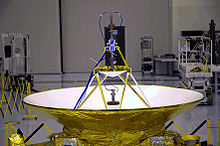
Communication with the spacecraft is viaX band.The craft had a communication rate of38 kbit/sat Jupiter; at Pluto's distance, a rate of approximately1kbit/sper transmitter was expected. Besides the low data rate, Pluto's distance also causes alatencyof about 4.5 hours (one-way). The 70 m (230 ft)NASA Deep Space Network(DSN) dishes are used to relay commands once the spacecraft is beyond Jupiter. The spacecraft usesdual modular redundancytransmitters and receivers, and either right- or left-handcircular polarization.
The downlink signal is amplified by dual redundant 12-watttraveling-wave tubeamplifiers (TWTAs) mounted on the body under the dish. The receivers are low-power designs. The system can be controlled to power both TWTAs at the same time, and transmit a dual-polarized downlink signal to the DSN that nearly doubles the downlink rate. DSN tests early in the mission with this dual polarization combining technique were successful, and the capability was declared to be operational (when the spacecraft power budget permits both TWTAs to be powered).
In addition to thehigh-gain antenna,there are two backup low-gain antennas and a medium-gain dish. The high-gain dish has aCassegrain reflectorlayout, composite construction, of 2.1-meter (7 ft) diameter providing over42dBiof gain and a half-power beam width of about a degree. The prime-focus medium-gain antenna, with a 0.3-meter (1 ft) aperture and 10° half-power beam width, is mounted to the forward-facing side of the high-gain antenna's secondary reflector. The forward low-gain antenna is stacked atop the feed of the medium-gain antenna. The aft low-gain antenna is mounted within the launch adapter at the rear of the spacecraft. This antenna was used only for early mission phases near Earth, just after launch and for emergencies if the spacecraft had lost attitude control.
New Horizonsrecorded scientific instrument data to its solid-state memory buffer at each encounter, then transmitted the data to Earth. Data storage is done on two low-powersolid-state recorders(one primary, one backup) holding up to8gigabytes each. Because of the extreme distance from Pluto and the Kuiper belt, only one buffer load at those encounters can be saved. This is becauseNew Horizonswould require approximately 16 months after leaving the vicinity of Pluto to transmit the buffer load back to Earth.[65]At Pluto's distance, radio signals from the space probe back to Earth took four hours and 25 minutes to traverse 4.7 billion km of space.[66]
Part of the reason for the delay between the gathering of and transmission of data is that all of theNew Horizonsinstrumentation is body-mounted. In order for the cameras to record data, the entire probe must turn, and the one-degree-wide beam of the high-gain antenna was not pointing toward Earth. Previous spacecraft, such as theVoyagerprogram probes, had a rotatable instrumentation platform (a "scan platform" ) that could take measurements from virtually any angle without losing radio contact with Earth.New Horizonswas mechanically simplified to save weight, shorten the schedule, and improve reliability during its 15-year designed lifetime.
TheVoyager 2scan platform jammed at Saturn, and the demands of long time exposures at outer planets led to a change of plans such that the entire probe was rotated to make photos at Uranus and Neptune, similar to howNew Horizonsrotated.
Instruments[edit]
New Horizonscarries seven instruments: three optical instruments, two plasma instruments, a dust sensor and a radio science receiver/radiometer. The instruments are to be used to investigate the global geology, surface composition, surface temperature, atmospheric pressure, atmospheric temperature and escape rate of Pluto and its moons. The rated power is21 watts,though not all instruments operate simultaneously.[67]In addition,New Horizonshas an Ultrastable Oscillator subsystem, which may be used to study and test thePioneer anomalytowards the end of the spacecraft's life.[68]
Long-Range Reconnaissance Imager (LORRI)[edit]
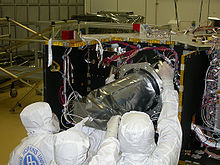
The Long-Range Reconnaissance Imager (LORRI) is a long-focal-length imager designed for high resolution and responsivity at visible wavelengths. The instrument is equipped with a 1024×1024 pixel by 12-bits-per-pixel monochromaticCCDimager giving a resolution of 5μrad(~1arcsec).[69]The CCD is chilled far below freezing by a passive radiator on the antisolar face of the spacecraft. This temperature differential requires insulation and isolation from the rest of the structure. The 208.3 mm (8.20 in) apertureRitchey–Chretienmirrors and metering structure are made ofsilicon carbideto boost stiffness, reduce weight and prevent warping at low temperatures. The optical elements sit in a composite light shield and mount with titanium and fiberglass for thermal isolation. Overall mass is 8.6 kg (19 lb), with the optical tube assembly (OTA) weighing about 5.6 kg (12 lb),[70]for one of the largest silicon-carbide telescopes flown at the time (now surpassed byHerschel). For viewing on public web sites the 12-bit per pixel LORRI images are converted to 8-bit per pixelJPEGimages.[69]These public images do not contain the fulldynamic rangeof brightness information available from the raw LORRI images files.[69]
- Principal investigator: Andy Cheng,Applied Physics Laboratory,Data: LORRI image search at jhuapl.edu[71]
Solar Wind Around Pluto (SWAP)[edit]
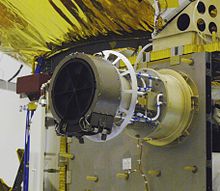
Solar Wind Around Pluto (SWAP) is a toroidalelectrostatic analyzerand retarding potential analyzer (RPA), that makes up one of the two instruments comprisingNew Horizons'Plasmaand high-energy particle spectrometer suite (PAM), the other being PEPSSI. SWAP measures particles of up to 6.5 keV and, because of the tenuous solar wind at Pluto's distance, the instrument is designed with the largestapertureof any such instrument ever flown.[72]
- Principal investigator: David McComas,Southwest Research Institute
Pluto Energetic Particle Spectrometer Science Investigation (PEPSSI)[edit]
Pluto Energetic Particle Spectrometer Science Investigation (PEPSSI) is atime of flightionandelectronsensor that makes up one of the two instruments comprisingNew Horizons'plasma and high-energy particle spectrometer suite (PAM), the other being SWAP. Unlike SWAP, which measures particles of up to 6.5 keV, PEPSSI goes up to 1 MeV.[72]The PEPSSI sensor has been designed to measure the mass, energy and distribution of charged particles around Pluto, and is also able to differentiate betweenprotons,electrons,and otherheavy ions.[73]
- Principal investigator: Ralph McNutt Jr., Applied Physics Laboratory
Alice[edit]
Aliceis anultravioletimagingspectrometerthat is one of two photographic instruments comprisingNew Horizons'Pluto Exploration Remote Sensing Investigation (PERSI); the other being theRalphtelescope. It resolves 1,024 wavelength bands in the far and extreme ultraviolet (from 50–180nm), over 32 view fields. Its goal is to determine the composition of Pluto's atmosphere. This Alice instrument is derived from another Alice aboardESA'sRosettaspacecraft.[72]The instrument has a mass of 4.4 kg and draws 4.4 watts of power. Its primary role is to determine the relative concentrations of various elements and isotopes in Pluto's atmosphere.[74]
- Principal investigator: Alan Stern, Southwest Research Institute
In August 2018, NASA confirmed, based on results byAliceon theNew Horizonsspacecraft, a "hydrogen wall"at the outer edges of theSolar Systemthat was first detected in 1992 by the twoVoyager spacecraft.[25][26]
Ralph telescope[edit]
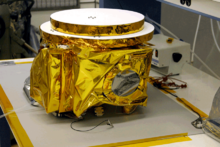
The Ralph telescope, 75 mm[75]in aperture, is one of two photographic instruments that make upNew Horizons'Pluto Exploration Remote Sensing Investigation (PERSI), with the other being the Alice instrument. Ralph has two separate channels: MVIC (Multispectral Visible Imaging Camera), a visible-lightCCDimager with broadband and color channels; and LEISA (Linear Etalon Imaging Spectral Array), a near-infraredimaging spectrometer. LEISA is derived from a similar instrument on theEarth Observing-1spacecraft. Ralph was named after Alice's husband onThe Honeymooners,and was designed after Alice.[76]
On June 23, 2017, NASA announced that it has renamed the LEISA instrument to the "Lisa Hardaway Infrared Mapping Spectrometer" in honor ofLisa Hardaway,the Ralph program manager atBall Aerospace,who died in January 2017 at age 50.[77]
- Principal investigator: Alan Stern, Southwest Research Institute
Venetia Burney Student Dust Counter (VBSDC)[edit]
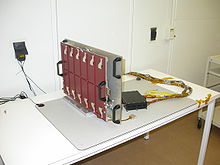
TheVenetia Burney Student Dust Counter(VBSDC), built by students at the University of Colorado Boulder, is operating periodically to makedustmeasurements.[78][79]It consists of a detector panel, about 460 mm × 300 mm (18 in × 12 in), mounted on the anti-solar face of the spacecraft (the ram direction), and an electronics box within the spacecraft. The detector contains fourteenpolyvinylidene difluoride(PVDF) panels, twelve science and two reference, which generate voltage when impacted. Effective collecting area is 0.125 m2(1.35 sq ft). No dust counter has operated past the orbit ofUranus;models of dust in the outer Solar System, especially the Kuiper belt, are speculative. The VBSDC is always turned on measuring the masses of the interplanetary and interstellar dust particles (in the range of nano- and picograms) as they collide with the PVDF panels mounted on theNew Horizonsspacecraft. The measured data is expected to greatly contribute to the understanding of the dust spectra of the Solar System. The dust spectra can then be compared with those from observations of other stars, giving new clues as to where Earth-like planets can be found in the universe. The dust counter is named forVenetia Burney,who first suggested the name "Pluto" at the age of 11. A thirteen-minute short film about the VBSDC garnered an Emmy Award for student achievement in 2006.[80]
- Principal investigator: Mihaly Horanyi,University of Colorado Boulder
Radio Science Experiment (REX)[edit]
The Radio Science Experiment (REX) used an ultrastablecrystal oscillator(essentially a calibrated crystal in a miniatureoven) and some additional electronics to conduct radio science investigations using the communications channels. These are small enough to fit on a single card. Because there are two redundant communications subsystems, there are two, identical REX circuit boards.
- Principal investigators: Len Tyler and Ivan Linscott,Stanford University
Journey to Pluto[edit]
Launch[edit]
On September 24, 2005, the spacecraft arrived at the Kennedy Space Center on board aC-17 Globemaster IIIfor launch preparations.[81]The launch ofNew Horizonswas originally scheduled for January 11, 2006, but was initially delayed until January 17, 2006, to allow forborescopeinspections of theAtlas V'skerosenetank. Further delays related to low cloud ceiling conditionsdownrange,and high winds and technical difficulties—unrelated to the rocket itself—prevented launch for a further two days.[82][83]
The probe finally lifted off fromPad 41atCape Canaveral Air Force Station,Florida,directly south ofSpace ShuttleLaunch Complex 39,at 19:00 UTC on January 19, 2006.[84][85]TheCentaursecond stage ignited at 19:04:43 UTC and burned for 5 minutes 25 seconds. It reignited at 19:32 UTC and burned for 9 minutes 47 seconds. TheATKStar 48B third stage ignited at 19:42:37 UTC and burned for 1 minute 28 seconds.[86]Combined, these burns successfully sent the probe on a solar-escape trajectory at 16.26 kilometers per second (58,536 km/h; 36,373 mph).[8]New Horizonstook only nine hours to pass the Moon's orbit.[87]Although there were backup launch opportunities in February 2006 and February 2007, only the first twenty-three days of the 2006 window permitted the Jupiter flyby. Any launch outside that period would have forced the spacecraft to fly a slower trajectory directly to Pluto, delaying its encounter by five to six years.[88]
The probe was launched by aLockheed MartinAtlas V 551 rocket, with a third stage added to increase the heliocentric (escape) speed. This was the first launch of the Atlas V 551 configuration, which uses fivesolid rocket boosters,and the first Atlas V with a third stage. Previous flights had used zero, two, or three solid boosters, but never five. The vehicle, AV-010, weighed 573,160 kilograms (1,263,600 lb) at lift-off,[86]and had earlier been slightly damaged whenHurricane Wilmaswept across Florida on October 24, 2005. One of the solid rocket boosters was hit by a door. The booster was replaced with an identical unit, rather than inspecting and requalifying the original.[89]
The launch was dedicated to the memory of launch conductorDaniel Sarokon,who was described by space program officials as one of the most influential people in the history of space travel.[90]
Inner Solar System[edit]
Trajectory corrections[edit]
On January 28 and 30, 2006, mission controllers guided the probe through its firsttrajectory-correction maneuver (TCM), which was divided into two parts (TCM-1A and TCM-1B). The total velocity change of these two corrections was about 18 meters per second (65 km/h; 40 mph). TCM-1 was accurate enough to permit the cancellation of TCM-2, the second of three originally scheduled corrections.[91]On March 9, 2006, controllers performed TCM-3, the last of three scheduled course corrections. The engines burned for 76 seconds, adjusting the spacecraft's velocity by about 1.16 m/s (4.2 km/h; 2.6 mph).[92]Further trajectory maneuvers were not needed until September 25, 2007 (seven months after the Jupiter flyby), when the engines were fired for 15 minutes and 37 seconds, changing the spacecraft's velocity by 2.37 m/s (8.5 km/h; 5.3 mph),[93]followed by another TCM, almost three years later on June 30, 2010, that lasted 35.6 seconds, whenNew Horizonshad already reached the halfway point (in time traveled) to Pluto.[94]
In-flight tests and crossing of Mars orbit[edit]
During the week of February 20, 2006, controllers conducted initial in-flight tests of three onboard science instruments, the Alice ultraviolet imaging spectrometer, the PEPSSI plasma-sensor, and the LORRI long-range visible-spectrum camera. No scientific measurements or images were taken, but instrument electronics, and in the case of Alice, some electromechanical systems were shown to be functioning correctly.[95]
On April 7, 2006, the spacecraft passed the orbit of Mars, moving at roughly 21 km/s (76,000 km/h; 47,000 mph) away from the Sun at a solar distance of 243 million kilometers.[96][97][98]
Asteroid 132524 APL[edit]
Because of the need to conserve fuel for possible encounters with Kuiper belt objects subsequent to the Pluto flyby, intentional encounters with objects in theasteroid beltwere not planned. After launch, theNew Horizonsteam scanned the spacecraft's trajectory to determine if any asteroids would, by chance, be close enough for observation. In May 2006 it was discovered thatNew Horizonswould pass close to the tiny asteroid132524 APLon June 13, 2006. Closest approach occurred at 4:05 UTC at a distance of 101,867 km (63,297 mi) (around one quarter of theaverage Earth-Moon distance). The asteroid was imaged by Ralph (use of LORRI was not possible because of proximity to the Sun), which gave the team a chance to test Ralph'scapabilities, and make observations of the asteroid's composition as well as light and phase curves. The asteroid was estimated to be 2.5 km (1.6 mi) in diameter.[99][100][101]The spacecraft successfully tracked the rapidly moving asteroid over June 10–12, 2006.
First Pluto sighting[edit]
The first images of Pluto fromNew Horizonswere acquired September 21–24, 2006, during a test of LORRI. They were released on November 28, 2006.[102]The images, taken from a distance of approximately 4.2 billion km (2.6 billion mi; 28 AU), confirmed the spacecraft's ability to track distant targets, critical for maneuvering toward Pluto and other Kuiper belt objects.
Jupiter encounter[edit]

New Horizonsused LORRI to take its first photographs of Jupiter on September 4, 2006, from a distance of 291 million kilometers (181 million miles).[103]More detailed exploration of the system began in January 2007 with an infrared image of the moonCallisto,as well as several black-and-white images of Jupiter itself.[104]New Horizonsreceived a gravity assist from Jupiter, with its closest approach at 05:43:40 UTC on February 28, 2007, when it was 2.3 million kilometers (1.4 million miles) from Jupiter. The flyby increasedNew Horizons'speed by 4 km/s (14,000 km/h; 9,000 mph), accelerating the probe to a velocity of 23 km/s (83,000 km/h; 51,000 mph) relative to the Sun and shortening its voyage to Pluto by three years.[105]
The flyby was the center of a four-month intensive observation campaign lasting from January to June. Being an ever-changing scientific target, Jupiter has been observed intermittently since the end of theGalileomission in September 2003. Knowledge about Jupiter benefited from the fact thatNew Horizons'instruments were built using the latest technology, especially in the area of cameras, representing a significant improvement overGalileo'scameras, which were modified versions ofVoyagercameras, which, in turn, were modifiedMarinercameras. The Jupiter encounter also served as a shakedown and dress rehearsal for the Pluto encounter. Because Jupiter is much closer to Earth than Pluto, the communications link can transmit multiple loadings of the memory buffer; thus the mission returned more data from the Jovian system than it was expected to transmit from Pluto.[106]
One of the main goals during the Jupiter encounter was observing itsatmospheric conditionsand analyzing the structure and composition of its clouds. Heat-induced lightning strikes in the polar regions and "waves" that indicate violent storm activity were observed and measured. TheLittle Red Spot,spanning up to 70% of Earth's diameter, was imaged from up close for the first time.[105]Recording from different angles and illumination conditions,New Horizonstook detailed images of Jupiter's faintring system,discovering debris left over from recent collisions within the rings or from other unexplained phenomena. The search for undiscovered moons within the rings showed no results. Travelling through Jupiter'smagnetosphere,New Horizonscollected valuable particle readings.[105]"Bubbles" of plasma that are thought to be formed from material ejected by the moon Io were noticed in themagnetotail.[107]
Jovian moons[edit]
The four largest moons of Jupiter were in poor positions for observation; the necessary path of the gravity-assist maneuver meant thatNew Horizonspassed millions of kilometers from any of theGalilean moons.Still, its instruments were intended for small, dim targets, so they were scientifically useful on large, distant moons. Emphasis was put on Jupiter's innermost Galilean moon,Io,whose active volcanoes shoot out tons of material into Jupiter's magnetosphere, and further. Out of eleven observed eruptions, three were seen for the first time. That ofTvashtarreached an altitude of up to 330 km (210 mi). The event gave scientists an unprecedented look into the structure and motion of the rising plume and its subsequent fall back to the surface. Infrared signatures of a further 36 volcanoes were noticed.[105]Callisto's surface was analyzed with LEISA, revealing how lighting and viewing conditions affect infrared spectrum readings of its surface water ice.[108]Minor moons such asAmaltheahad their orbit solutions refined. The cameras determined their positions, acting as "reverse optical navigation".
Outer Solar System[edit]
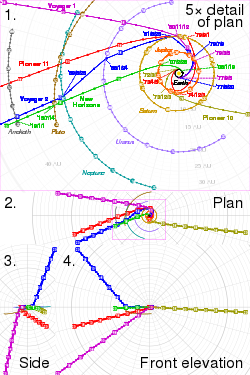
Plot 1is viewed from thenorth ecliptic pole,to scale.
Plots 2 to 4arethird-angle projectionsat 20% scale.
Inthe SVG file,hover over a trajectory or orbit to highlight it and its associated launches and flybys.
After passing Jupiter,New Horizonsspent most of its journey towards Pluto in hibernation mode. Redundant components as well as guidance and control systems were shut down to extend their life cycle, decrease operation costs and free theDeep Space Networkfor other missions.[109]During hibernation mode, the onboard computer monitored the probe's systems and transmitted a signal back to Earth; a "green" code if everything was functioning as expected or a "red" code if mission control's assistance was needed.[109]The probe was activated for about two months a year so that the instruments could be calibrated and the systems checked. The first hibernation mode cycle started on June 28, 2007,[109]the second cycle began on December 16, 2008,[110]the third cycle on August 27, 2009,[111]and the fourth cycle on August 29, 2014, after a 10-week test.[112]
New Horizonscrossed the orbit ofSaturnon June 8, 2008,[113]andUranuson March 18, 2011.[114]After astronomers announced the discovery of two new moons in the Pluto system,KerberosandStyx,mission planners started contemplating the possibility of the probe running into unseen debris and dust left over from ancient collisions between the moons. A study based on 18 months of computer simulations, Earth-based telescope observations and occultations of the Pluto system revealed that the possibility of a catastrophic collision with debris or dust was less than 0.3% on the probe's scheduled course.[115][116]If the hazard increased,New Horizonscould have used one of two possible contingency plans, the so-called SHBOTs (Safe Haven by Other Trajectories). Either the probe could have continued on its present trajectory with the antenna facing the incoming particles so the more vital systems would be protected, or it could have positioned its antenna to make a course correction that would take it just 3000 km from the surface of Pluto where it was expected that theatmospheric dragwould have cleaned the surrounding space of possible debris.[116]
While in hibernation mode in July 2012,New Horizonsstarted gathering scientific data with SWAP, PEPSSI and VBSDC. Although it was originally planned to activate just the VBSDC, other instruments were powered on in order to collect valuable heliospheric data. Before activating the other two instruments, ground tests were conducted to make sure that the expanded data gathering in this phase of the mission would not limit available energy, memory and fuel in the future and that all systems were functioning during the flyby.[117]The first set of data was transmitted in January 2013 during a three-week activation from hibernation. The command and data handling software was updated to address the problem of computer resets.[118]
Possible Neptune trojan targets[edit]
Other possible targets wereNeptune trojans.The probe's trajectory to Pluto passed near Neptune's trailingLagrange point( "L5"), which may host hundreds of bodies in 1:1resonance.In late 2013,New Horizonspassed within 1.2 AU (180 million km; 110 million mi) of the high-inclination L5 Neptune trojan2011 HM102,[119]which was discovered shortly before by theNew Horizons KBO Searchtask, asurveyto find additionaldistant objectsforNew Horizonsto fly by after its 2015 encounter with Pluto. At that range,2011 HM102would have been bright enough to be detectable byNew Horizons'LORRI instrument; however, theNew Horizonsteam eventually decided that they would not target2011 HM102for observations because the preparations for the Pluto approach took precedence.[120]On August 25, 2014,New Horizonscrossed the orbit ofNeptune,exactly 25 years after the planet was visited by theVoyager 2probe.[121]This was the last major planet orbit crossing before the Pluto flyby. At the time, the spacecraft was 3.99 billion km (2.48 billion mi; 26.7 AU) away from Neptune and 4.51 billion km (2.80 billion mi; 30.1 AU) from the Sun.
Observations of Pluto and Charon 2013–14[edit]
Images from July 1 to 3, 2013, by LORRI were the first by the probe to resolve Pluto and Charon as separate objects.[122]On July 14, 2014, mission controllers performed a sixth trajectory-correction maneuver (TCM) since its launch to enable the craft to reach Pluto.[123]Between July 19–24, 2014,New Horizons'LORRI snapped 12 images of Charon revolving around Pluto, covering almost one full rotation at distances ranging from about 429 to 422 million km (267 to 262 million mi).[124]In August 2014, astronomers made high-precision measurements of Pluto's location and orbit around the Sun using the Atacama Large Millimeter/submillimeter Array (ALMA), an array of radio telescopes located in Chile, to help NASA'sNew Horizonsspacecraft accurately home in on Pluto.[125]On December 6, 2014, mission controllers sent a signal for the craft to "wake up" from its final Pluto-approach hibernation and begin regular operations. The craft's response that it was "awake" reached Earth on December 7, 2014, at 02:30 UTC.[126][127][128]
Pluto approach[edit]
Distant-encounter operations at Pluto began on January 4, 2015.[129]On this date, images of the targets with the onboard LORRI imager plus the Ralph telescope were only a fewpixelsin width. Investigators began taking Pluto images and background starfield images to assist mission navigators in the design of course-correcting engine maneuvers that would precisely modify the trajectory ofNew Horizonsto aim the approach.[130]
On February 12, 2015, NASA released new images of Pluto (taken from January 25 to 31) from the approaching probe.[131][132]New Horizonswas more than 203 million km (126 million mi) away from Pluto when it began taking the photos, which showed Pluto and its largest moon, Charon. The exposure time was too short to see Pluto's smaller, much fainter moons.
Investigators compiled a series of images of the moons Nix and Hydra taken from January 27 through February 8, 2015, beginning at a range of 201 million km (125 million mi).[133]Pluto and Charon appear as a single overexposed object at the center. The right side image has been processed to remove the background starfield. The other two, even smaller moons—Kerberos and Styx—were seen on photos taken on April 25.[134]Starting on May 11, a hazard search was performed, looking for unknown objects that could be a danger to the spacecraft, such as rings or hitherto undiscovered moons, which could then possibly be avoided by a course change.[135]No rings or additional moons were found.
Also in regard to the approach phase during January 2015, on August 21, 2012, the team announced that they would spend mission time attempting long-range observations of the Kuiper belt object temporarily designatedVNH0004(now designated2011 KW48), when the object was at a distance of 75 million km (0.50 AU; 47 million mi) fromNew Horizons.[136]The object would be too distant to resolve surface features or take spectroscopy, but it would be able to make observations that cannot be made from Earth, namely aphase curveand a search for small moons. A second object was planned to be observed in June 2015, and a third in September after the flyby; the team hoped to observe a dozen such objects through 2018.[136]On April 15, 2015, Pluto was imaged showing a possible polar cap.[137]
Software glitch[edit]
On July 4, 2015,New Horizonsexperienced a software anomaly and went into safe mode, preventing the spacecraft from performing scientific observations until engineers could resolve the problem.[138][139]On July 5, NASA announced that the problem was determined to be a timing flaw in a command sequence used to prepare the spacecraft for its flyby, and the spacecraft would resume scheduled science operations on July 7. The science observations lost because of the anomaly were judged to have no impact on the mission's main objectives and minimal impact on other objectives.[140]
The timing flaw consisted of performing two tasks simultaneously—compressing previously acquired data to release space for more data, and making a second copy of the approach command sequence—that together overloaded the spacecraft's primary computer. After the overload was detected, the spacecraft performed as designed: it switched from the primary computer to the backup computer, entered safe mode, and sent a distress call back to Earth. The distress call was received the afternoon of July 4 and alerted engineers that they needed to contact the spacecraft to get more information and resolve the issue. The resolution was that the problem happened as part of preparations for the approach, and was not expected to happen again because no similar tasks were planned for the remainder of the encounter.[140][141]
Pluto system encounter[edit]
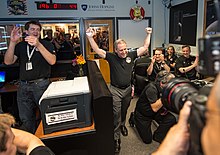
The closest approach of theNew Horizonsspacecraft to Pluto occurred at 11:49 UTC on July 14, 2015, at a range of 12,472 km (7,750 mi) from the surface[142]and 13,658 km (8,487 mi) from the center of Pluto.Telemetrydata confirming a successful flyby and a healthy spacecraft was received on Earth from the vicinity of the Pluto system on July 15, 2015, 00:52:37 UTC,[143]after 22 hours of plannedradio silencedue to the spacecraft being pointed towards thePluto system.Mission managers estimated a one in 10,000 chance that debris could have destroyed the probe or its communication-systems during the flyby, preventing it from sending data to Earth.[144]The first details of the encounter were received the next day, but the download of the complete data set through the 2kbpsdata downlink took just over 15 months,[18]and analysis of the data continues as of 2021.[145]
Objectives[edit]
The mission's science objectives were grouped in three distinct priorities. The "primary objectives" were required. The "secondary objectives" were expected to be met but were not demanded. The "tertiary objectives" were desired. These objectives could have been skipped in favor of the above objectives. An objective to measure any magnetic field of Pluto was dropped, due to mass and the expense associated with including amagnetometeron the spacecraft. Instead,SWAP and PEPSSIcould indirectly detect magnetic fields around Pluto.[146]
- Primary objectives (required)
- Characterize the global geology and morphology of Pluto and Charon
- Map chemical compositions of Pluto and Charon surfaces
- Characterize the neutral (non-ionized)atmosphere of Plutoand its escape rate
- Secondary objectives (expected)
- Characterize the time variability of Pluto's surface and atmosphere
- Image select Pluto and Charon areas instereo
- Map theterminators(day/night border) of Pluto and Charon with high resolution
- Map the chemical compositions of select Pluto and Charon areas with high resolution
- Characterize Pluto'sionosphere(upper layer of the atmosphere) and its interaction with thesolar wind
- Search formolecular neutral speciessuch asmolecular hydrogen,hydrocarbons,hydrogen cyanideand othernitrilesin the atmosphere
- Search for any Charon atmosphere
- DeterminebolometricBond albedosfor Pluto and Charon
- Map surface temperatures of Pluto and Charon
- Map any additional surfaces of outermost moons:Nix,Hydra,Kerberos,andStyx
- Tertiary objectives (desired)
"The New Horizons flyby of the Pluto system was fully successful, meeting and in many cases exceeding, the Pluto objectives set out for it by NASA and the National Academy of Sciences."[147]
Flyby details[edit]
New Horizonspassed within 12,500 km (7,800 mi) of Pluto, with this closest approach on July 14, 2015, at 11:50 UTC.New Horizonshad a relative velocity of 13.78 km/s (49,600 km/h; 30,800 mph) at its closest approach, and came as close as 28,800 km (17,900 mi) to Charon. Starting 3.2 days before the closest approach, long-range imaging included the mapping of Pluto and Charon to 40 km (25 mi) resolution. This is half the rotation period of the Pluto–Charon system and allowed imaging of all sides of both bodies. Close range imaging was repeated twice per day in order to search for surface changes caused by localized snow fall or surfacecryovolcanism.Because of Pluto's tilt, a portion of the northern hemisphere would be in shadow at all times. During the flyby, engineers expected LORRI to be able to obtain select images with resolution as high as 50 m per pixel (160 ft/px) if closest distance were around 12,500 km (7,800 mi), and MVIC was expected to obtain four-color global dayside maps at 1.6 km (1 mi) resolution. LORRI and MVIC attempted to overlap their respective coverage areas to form stereo pairs. LEISA obtained hyperspectral near-infrared maps at 7 km/px (4.3 mi/px) globally and 0.6 km/px (0.37 mi/px) for selected areas.
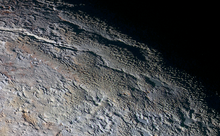
Meanwhile, Alice characterized the atmosphere, both by emissions of atmospheric molecules (airglow), and by dimming of background stars as they pass behind Pluto (occultation). During and after closest approach, SWAP and PEPSSI sampled the high atmosphere and its effects on the solar wind. VBSDC searched for dust, inferring meteoroid collision rates and any invisible rings. REX performed active and passive radio science. The communications dish on Earth measured the disappearance and reappearance of theradio occultationsignal as the probe flew by behind Pluto. The results resolved Pluto's diameter (by their timing) and atmospheric density and composition (by their weakening and strengthening pattern). (Alice can perform similar occultations, using sunlight instead of radio beacons.) Previous missions had the spacecraft transmit through the atmosphere, to Earth ( "downlink" ). Pluto's mass and mass distribution were evaluated by the gravitational tug on the spacecraft. As the spacecraft speeds up and slows down, the radio signal exhibited aDoppler shift.The Doppler shift was measured by comparison with the ultrastable oscillator in the communications electronics.
Reflected sunlight from Charon allowed some imaging observations of the nightside. Backlighting by the Sun gave an opportunity to highlight any rings or atmospheric hazes. REX performed radiometry of the nightside.
Satellite observations[edit]
New Horizons'best spatial resolution of the small satellites is 330 m per pixel (1,080 ft/px) at Nix, 780 m/px (2,560 ft/px) at Hydra, and approximately 1.8 km/px (1.1 mi/px) at Kerberos and Styx. Estimates for the dimensions of these bodies are: Nix at 49.8 × 33.2 × 31.1 km (30.9 × 20.6 × 19.3 mi); Hydra at 50.9 × 36.1 × 30.9 km (31.6 × 22.4 × 19.2 mi); Kerberos at 19 × 10 × 9 km (11.8 × 6.2 × 5.6 mi); and Styx at 16 × 9 × 8 km (9.9 × 5.6 × 5.0 mi).[148]
Initial predictions envisioned Kerberos as a relatively large and massive object whose dark surface led to it having a faint reflection. This proved to be wrong as images obtained byNew Horizonson July 14 and sent back to Earth in October 2015 revealed that Kerberos was smaller in size, 19 km (12 mi) across with a highly reflective surface suggesting the presence of relatively clean water ice similarly to the rest of Pluto's smaller moons.[149]
Post-Pluto events[edit]

Soon after the Pluto flyby, in July 2015,New Horizonsreported that the spacecraft was healthy, its flight path was within the margins, and science data of the Pluto–Charon system had been recorded.[150][151]The spacecraft's immediate task was to begin returning the 6.25 gigabytes of information collected.[18]Thefree-space path lossat its distance of 4.5light-hours(3 billion km or 20 AU or 1.9 billion mi) is approximately 303dBat 7 GHz. Using thehigh gain antennaand transmitting at full power, the signal fromEIRPis +83 dBm, and at this distance, the signal reaching Earth is −220 dBm. The received signal level (RSL) using one, un-arrayedDeep Space Networkantenna with 72 dBi of forward gain equals −148 dBm.[152]Because of the extremely low RSL, it could only transmit data at 1 to 2kilobits per second.[153]
By March 30, 2016, about nine months after the flyby,New Horizonsreached the halfway point of transmitting this data.[154]The transfer was completed on October 25, 2016, at 21:48 UTC, when the last piece of data—part of a Pluto–Charon observation sequence by the Ralph/LEISA imager—was received by the Johns Hopkins UniversityApplied Physics Laboratory.[18][155]
As of November 2018, at a distance of 43 AU (6.43 billion km; 4.00 billion mi) from the Sun and 0.4 AU (60 million km; 37 million mi) from 486958 Arrokoth,[156]New Horizonswasheading in the directionof the constellationSagittarius[157]at 14.10km/s(8.76mi/s;2.97AU/a) relative to the Sun.[156]The brightness of the Sun from the spacecraft wasmagnitude−18.5.[157]
On April 17, 2021,New Horizonsreached a distance of 50 AU from the Sun, while remaining fully operational.[158]
Mission extension[edit]

TheNew Horizonsteam requested, and received, a mission extension through 2021 to explore additional Kuiper belt objects (KBOs). Funding was secured on July 1, 2016.[159]During this Kuiper Belt Extended Mission (KEM) the spacecraft performed a close fly-by of486958 Arrokothand will conduct more distant observations of an additional two dozen objects,[160][159][161]and possibly make a fly-by of another KBO.[citation needed]
Kuiper belt object mission[edit]
Target background[edit]
Mission planners searched for one or more additional Kuiper belt objects (KBOs) of the order of 50–100 km (31–62 mi) in diameter as targets for flybys similar to the spacecraft's Plutonian encounter. However, despite the large population of KBOs, many factors limited the number of possible targets. Because the flight path was determined by the Pluto flyby, and the probe only had 33 kilograms ofhydrazinepropellantremaining, the object to be visited needed to be within a cone of less than a degree's width extending from Pluto. The target also needed to be within 55 AU, because beyond 55 AU, the communications link becomes too weak, and the RTG power output decays significantly enough to hinder observations.[162]Desirable KBOs are well over 50 km (30 mi) in diameter, neutral in color (to contrast with the reddish Pluto), and, if possible, have a moon that imparts a wobble.[citation needed]
KBO Search[edit]
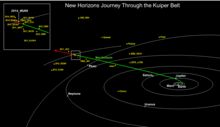
In 2011, mission scientists started theNew Horizons KBO Search,a dedicatedsurveyfor suitable KBOs using ground telescopes. Large ground telescopes with wide-field cameras, notably the twin 6.5-meterMagellan Telescopesin Chile, the 8.2-meterSubaru Observatoryin Hawaii and theCanada–France–Hawaii Telescope[119][163]were used to search for potential targets. By participating in acitizen-scienceproject calledIce Huntersthe public helped to scan telescopic images for possible suitable mission candidates.[164][165][166][167][168]The ground-based search resulted in the discovery of about 143 KBOs of potential interest,[169]but none of these were close enough to the flight path ofNew Horizons.[163]Only theHubble Space Telescopewas deemed likely to find a suitable target in time for a successful KBO mission.[170]On June 16, 2014, time on Hubble was granted for a search.[171]Hubble has a much greater ability to find suitable KBOs than ground telescopes. The probability that a target forNew Horizonswould be found was estimated beforehand at about 95%.[172]
Suitable KBOs[edit]

On October 15, 2014, it was revealed that Hubble's search had uncovered three potential targets,[173][174][175][176][177]temporarily designated PT1 ( "potential target 1" ), PT2 and PT3 by theNew Horizonsteam. PT1 was eventually chosen as the target and would be named486958 Arrokoth.
All objects had estimated diameters in the 30–55 km (19–34 mi) range and were too small to be seen by ground telescopes. The targets were at distances from the Sun ranging from 43 to 44 AU, which would put the encounters in the 2018–2019 period.[174]The initial estimated probabilities that these objects were reachable withinNew Horizons'fuel budget were 100%, 7%, and 97%, respectively.[174]All were members of the "cold" (low-inclination,low-eccentricity)classical Kuiper beltobjects, and thus were very different from Pluto.
PT1(given the temporary designation "1110113Y" on the HST web site[178]), the most favorably situated object, had a magnitude of 26.8, is 30–45 km (19–28 mi) in diameter, and was encountered in January 2019.[179]A course change to reach it required about 35% ofNew Horizons'availabletrajectory-adjustment fuel supply.A mission to PT3 was in some ways preferable, in that it is brighter and therefore probably larger than PT1, but the greater fuel requirements to reach it would have left less for maneuvering and unforeseen events.[174]
Once sufficient orbital information was provided, theMinor Planet Centergaveprovisional designationsto the three target KBOs:2014 MU69(later 486958 Arrokoth) (PT1),2014 OS393(PT2), and2014 PN70(PT3). By the fall of 2014, a possible fourth target,2014 MT69,had been eliminated by follow-up observations. PT2 was out of the running before the Pluto flyby.[180][181]
KBO selection[edit]
On August 28, 2015, 486958Arrokoth(then known as(486958) 2014 MU69and nicknamedUltima Thule) (PT1) was chosen as the flyby target. The necessary course adjustment was performed with four engine firings between October 22 and November 4, 2015.[182][183]The flyby occurred on January 1, 2019, at 00:33 UTC.[184][185]
Observations of other KBOs[edit]
Aside from its flyby of 486958 Arrokoth, the extended mission forNew Horizonscalls for the spacecraft to conduct observations of, and look for ring systems around, between 25 and 35 different KBOs.[186]In addition, it will continue to study the gas, dust and plasma composition of the Kuiper belt before the mission extension ends in 2021.[160][161][needs update]
On November 2, 2015,New Horizonsimaged KBO15810 Arawnwith the LORRI instrument from 280 million km away (170 million mi; 1.9 AU).[187]This KBO was again imaged by the LORRI instrument on April 7–8, 2016, from a distance of 111 million km (69 million mi; 0.74 AU). The new images allowed the science team to further refine the location of 15810 Arawn to within 1,000 km (620 mi) and to determine its rotational period of 5.47 hours.[188][189]
In July 2016, the LORRI camera captured some distant images ofQuaoarfrom 2.1 billion km away (1.3 billion mi; 14 AU); the oblique view will complement Earth-based observations to study the object's light-scattering properties.[190]
On December 5, 2017, whenNew Horizonswas 40.9 AU from Earth, a calibration image of theWishing Well clustermarked the most distant image ever taken by a spacecraft (breaking the 27-year record set byVoyager 1's famousPale Blue Dot). Two hours later,New Horizonssurpassed its own record, imaging the Kuiper belt objects2012 HZ84and2012 HE85from a distance of 0.50 and 0.34 AU, respectively. These were the closest images taken of a Kuiper belt object besides Pluto and Arrokoth as of February 2018[update].[191][192]
The dwarf planetHaumeawas observed from afar by theNew Horizonsspacecraft in October 2007, January 2017, and May 2020, from distances of 49 AU, 59 AU, and 63 AU, respectively.New Horizonshas observed the dwarf planets Eris (2020), Haumea (2007, 2017, 2020), Makemake (2007, 2017), and Quaoar (2016, 2017, 2019), as well as the large KBOsIxion(2016),2002 MS4(2016, 2017, 2019), and2014 OE394(2017, 2018). It also observed Neptune's largest moonTriton(which shares similarities with Pluto and Eris) in 2019.[193]
By December 2023,New Horizonshad discovered a total of about 100 KBOs, and flown close enough to about 20 of them to capture characteristics such as shape, rotational period, possible moons, and surface composition. In addition, since 2021, Canadian researchers had been able to usemachine learningsoftware to speed up identification processes of potential KBO targets for a third flyby, cutting weeks-long efforts to hours-long.[193][194]
Encounter with Arrokoth[edit]
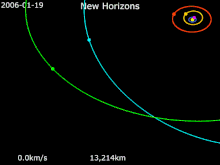
New Horizons·486958 Arrokoth·Earth·132524 APL·Jupiter·Pluto
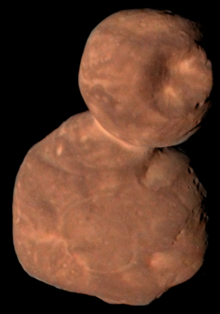
Objectives[edit]
Science objectives of the flyby included characterizing the geology and morphology ofArrokoth[195][196]and mapping the surface composition (by searching for ammonia, carbon monoxide, methane, and water ice). Searches will be conducted for orbiting moonlets, a coma, rings and the surrounding environment.[197]Additional objectives include:[198]
- Mapping the surface geology to learn how it formed and evolved
- Measuring the surface temperature
- Mapping the 3-D surface topography and surface composition to learn how it is similar to and different from comets such as67P/Churyumov–Gerasimenkoand dwarf planets such as Pluto
- Searching for any signs of activity, such as a cloud-like coma
- Searching for and studying any satellites or rings
- Measuring or constraining the mass
Targeting maneuvers[edit]
Arrokoth is the first object to be targeted for a flyby that was discovered after the spacecraft was launched.[199]New Horizonswas planned to come within 3,500 km (2,200 mi) of Arrokoth, three times closer than the spacecraft's earlier encounter with Pluto. Images with a resolution of up to 30 m (98 ft) per pixel were expected.[200]
The new mission began on October 22, 2015, whenNew Horizonscarried out the first in a series of four initial targeting maneuvers designed to send it towards Arrokoth. The maneuver, which started at approximately 19:50 UTC and used two of the spacecraft's small hydrazine-fueled thrusters, lasted approximately 16 minutes and changed the spacecraft's trajectory by about 10 meters per second (33 ft/s). The remaining three targeting maneuvers took place on October 25, October 28, and November 4, 2015.[201][202]
Approach phase[edit]
The craft was brought out of its hibernation at approximately 00:33UTCSCETon June 5, 2018 (06:12 UTCERT,Earth-Received Time),[a]in order to prepare for the approach phase.[204][205]After verifying its health status, the spacecraft transitioned from aspin-stabilizedmode to a three-axis-stabilized mode on August 13, 2018. The official approach phase began on August 16, 2018, and continued through December 24, 2018.[206]
New Horizonsmade its first detection of Arrokoth on August 16, 2018, from a distance of 107 million mi (172 million km). At that time, Arrokoth was visible at magnitude 20 against a crowded stellar background in the direction of the constellationSagittarius.[207][208]
Flyby[edit]
The Core phase began a week before the encounter and continued for two days after the encounter. The spacecraft flew by the object at a speed of 51,500 km/h (32,000 mph; 14.3 km/s) and within 3,500 km (2,200 mi).[209]The majority of the science data was collected within 48 hours of the closest approach in a phase called the Inner Core.[206]Closest approach occurred January 1, 2019, at 05:33UTC[210]SCETat which point the probe was43.4AUfrom theSun.[211]At this distance, the one-way transit time for radio signals between Earth andNew Horizonswas six hours.[197]Confirmation that the craft had succeeded in filling its digital recorders occurred when data arrived on Earth ten hours later, at 15:29 UTC.[212]
Data download[edit]
After the encounter, preliminary, high-priority data was sent to Earth on January 1 and 2, 2019. On January 9,New Horizonsreturned to a spin-stabilized mode to prepare sending the remainder of its data back to Earth.[206]This download was expected to take 20 months at a data rate of 1–2kilobits per second.[213] As of July 2022, approximately 10% of the data was still left to be received.[214]
Post-Arrokoth events[edit]
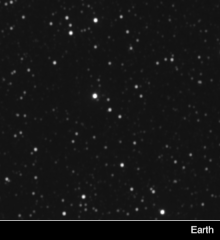
In April 2020,New Horizonswas used in conjunction with telescopes on Earth to take pictures of nearby starsProxima CentauriandWolf 359;the images from each vantage point – over 4 billion miles (6.4 billion km) apart – were compared to produce "the first demonstration of an easily observablestellar parallax."[215]
Images taken by the LORRI camera whileNew Horizonswas 42 to 45 AU from the Sun were used to measure the cosmic optical background, the visible light analog of thecosmic microwave background,in seven high galactic latitude fields. At that distanceNew Horizonssaw a sky ten times darker than the sky seen by theHubble Space Telescopebecause of the absence of diffuse background sky brightness from thezodiacal lightin the inner solar system. These measurements indicate that the total amount of light emitted by all galaxies at ultraviolet and visible wavelengths may be lower than previously thought.[216][217]

The spacecraft reached a distance of 50 AU (7.5 billion km; 4.6 billion mi) on April 17, 2021, at 12:42 UTC, a feat performed only four times before, byPioneer 10,Pioneer 11,Voyager 1,andVoyager 2.Voyager 1is the farthest spacecraft from the Sun, more than 152 AU (22.7 billion km; 14.1 billion mi) away whenNew Horizonsreached its landmark in 2021.[158]The support team continued to use the spacecraft in 2021 to study theheliosphericenvironment (plasma, dust and gas) and to study other Kuiper Belt objects.[218]
Plans[edit]
After the spacecraft passed Arrokoth, the instruments continue to have enough power to be operational until the 2030s.
Team leader Alan Stern stated there is potential for a third flyby in the 2020s at the outer edges of the Kuiper belt.[219][220]This depends on a suitable Kuiper belt object being found or confirmed close enough to the spacecraft's current trajectory. Since May 2020, theNew Horizonsteam has been using time on theSubaru Telescopeto look for suitable candidates within the spacecraft's proximity. As of June 2024, no suitable targets have been found. Beginning in 2025,New Horizonswill focus on specific heliophysics data, as stated by NASA in September 2023. It will remain available for a flyby of a different target until it leaves the Kuiper belt in 2028.[221]
New Horizonsmay also take a picture of Earth from its distance in the Kuiper belt, but only after completing all planned KBO flybys and imaging Uranus and Neptune.[222][223]This is because pointing a camera towards Earth could cause the camera to be damaged by sunlight,[224]as none ofNew Horizons'cameras have an active shutter mechanism.[225][226]
Speed[edit]

New Horizonshas been called "the fastest spacecraft ever launched"[7]because it left Earth at 16.26 kilometers per second (58,536 km/h; 36,373 mph).[8][9]It is also the first spacecraft launched directly into a solar escape trajectory, which requires an approximate speed while near Earth of 16.5 km/s (59,000 km/h; 37,000 mph),[b]plus additionaldelta-vto coverairandgravity drag,all to be provided by the launch vehicle. As of May 2, 2024, the spacecraft is 58.80 AU (8.796 billion km; 5.466 billion mi) from the Sun traveling at 13.68 kilometres per second (49,200 km/h; 30,600 mph).[227]
However, it is not the fastest spacecraft to leave the Solar System. As of July 2023[update],this record is held byVoyager 1,traveling at 16.985 km/s (61,146 km/h; 37,994 mph) relative to the Sun.[157]Voyager 1attained greaterhyperbolic excess velocitythanNew Horizonsdue togravity assistsby Jupiter and Saturn. WhenNew Horizonsreaches the distance of 100 AU (15 billion km; 9.3 billion mi), it will be traveling at about 13 km/s (47,000 km/h; 29,000 mph), around 4 km/s (14,000 km/h; 8,900 mph) slower thanVoyager 1at that distance.[228]TheParker Solar Probecan also be measured as the fastest object, because of itsorbital speedrelative to the Sun atperihelion:95.3 km/s (343,000 km/h; 213,000 mph).[c]Because it remains in solar orbit, itsspecific orbital energyrelative to the Sun is lower thanNew Horizonsand otherartificial objects escaping the Solar System.
New Horizons'Star 48Bthird stage is also on ahyperbolic escape trajectoryfrom the Solar System and reached Jupiter before theNew Horizonsspacecraft; it was expected to cross Pluto's orbit on October 15, 2015.[229]Because it was not in controlled flight, it did not receive the correct gravity assist and passed within 200 million km (120 million mi) of Pluto.[229]TheCentaursecond stage did not achieve solar escape velocity and remains in a heliocentric orbit.[230][c]
Gallery[edit]
Images of the launch[edit]
Videos[edit]
See also[edit]
- 2006 in spaceflight
- Exploration of Pluto
- Exploration of dwarf planets
- List of artificial objects leaving the Solar System
- List of missions to the outer planets
- List ofNew Horizonstopics
- Mariner Mark II,a planned family of NASA spacecraft including a Pluto mission
- New Horizons 2,a proposed trans-Neptunian object flyby mission
- Pioneer 10
- Pioneer 11
- Pluto Kuiper Express,a cancelled NASA Pluto flyby mission
- TAU,a proposed mission to fly by Pluto
- Timeline of Solar System exploration
- Voyager 1
- Voyager 2
Notes[edit]
- ^Confirmation thatNew Horizonsexited hibernation was received by ground stations at 06:12 UTC.Spacecraft Event Timeis calculated by subtracting the one-way light-travel time (5 hours, 38 minutes, 38 seconds) from Earth-received time.[203]
- ^To escape the Sun, the spacecraft needs a speed relative to the Sun of the square root of 2 times the speed of the Earth, which is 29.78 km/s. (In other words,.) Relative to the Earth, this is just 12.3 km/s. But the kinetic energy when near the surface of the Earth must include the energy to exit the gravity well of the Earth, which requires a speed of about 11 km/s. The total speed needed is the square root of the sum of the squares of these two speeds.[citation needed]
- ^abTheParker Solar Probeis expected to beat this record at its nextperihelionin April 2019.[needs update]Following several moregravity assistsat Venus, the spacecraft is expected to reach a maximum speed at perihelion of approximately 200 km/s (720,000 km/h; 450,000 mph) on December 24, 2024.[231]
References[edit]
- ^"New Horizons".NASA's Solar System Exploration website.RetrievedDecember 1,2022.
- ^abCleary, Mark C. (August 2010).Evolved Expendable Launch Operations at Cape Canaveral, 2002–2009(PDF)(Report). Air Force Space & Missile Museum. p. 30. Archived fromthe original(PDF)on January 3, 2020.RetrievedJanuary 3,2020.
{{cite report}}:Unknown parameter|agency=ignored (help) - ^"Atlas Launch Archives".International Launch Services.Archivedfrom the original on April 22, 2018.RetrievedApril 21,2018.
- ^"HORIZONS Web-Interface".NASA/JPL.Archivedfrom the original on October 7, 2012.RetrievedJuly 25,2016.To find results, change Target Body to "New Horizons", Center to "@Sun", and Time Span to include "2017-01-01".
- ^Chang, Kenneth (July 18, 2015)."The Long, Strange Trip to Pluto, and How NASA Nearly Missed It".The New York Times.Archivedfrom the original on September 20, 2019.RetrievedJuly 19,2015.
- ^abLeo Laporte(August 31, 2015)."Alan Stern: principal investigator for New Horizons".TWiT.tv(Podcast).RetrievedSeptember 1,2015.
- ^ab"New Horizons, The First Mission to Pluto and the Kuiper Belt: Exploring Frontier Worlds"(PDF)(Press Kit).Applied Physics Laboratory.January 16, 2007.
- ^abcScharf, Caleb A. (February 25, 2013)."The Fastest Spacecraft Ever?".Scientific American.RetrievedJuly 12,2017.
- ^abDvorsky, George (June 9, 2015)."Here's Why The New Horizons Spacecraft Won't Be Stopping At Pluto".io9.RetrievedJuly 12,2017.
- ^Whitwam, Ryan (December 13, 2017)."New Horizons Space Probe Target May Have its Own Tiny Moonlet – ExtremeTech".Ziff Davis.RetrievedJanuary 24,2019.
- ^"New Horizons: NASA's Mission to Pluto".NASA.RetrievedApril 15,2015.
- ^"New Horizons – News".Johns Hopkins Applied Physics Laboratory.December 6, 2014.RetrievedApril 15,2015.
- ^Chang, Kenneth (July 14, 2015)."NASA's New Horizons Spacecraft Completes Flyby of Pluto".The New York Times.Archivedfrom the original on January 18, 2018.RetrievedJuly 14,2015.
- ^Dunn, Marcia (July 14, 2015)."Pluto close-up: Spacecraft makes flyby of icy, mystery world".Excite.Associated Press (AP).Archivedfrom the original on July 16, 2015.RetrievedJuly 14,2015.
- ^"New Horizons".NASA.RetrievedMarch 10,2023.
- ^Brown, Dwayne; Cantillo, Laurie; Buckley, Mike; Stotoff, Maria (July 14, 2015)."15-149 NASA's Three-Billion-Mile Journey to Pluto Reaches Historic Encounter".NASA.Archivedfrom the original on June 17, 2019.RetrievedJuly 14,2015.
- ^Cofield, Calia (August 24, 2016)."How We Could Visit the Possibly Earth-Like Planet Proxima b".Space.RetrievedOctober 1,2019.
- ^abcdChang, Kenneth (October 28, 2016)."No More Data From Pluto".The New York Times.Archivedfrom the original on March 29, 2019.RetrievedOctober 28,2016.
- ^Jayawardhana, Ray (December 11, 2015)."Give It Up for Pluto".The New York Times.Archivedfrom the original on July 10, 2018.RetrievedDecember 11,2015.
- ^abTalbert, Tricia (August 28, 2015)."NASA's New Horizons Team Selects Potential Kuiper Belt Flyby Target".NASA.Archivedfrom the original on September 26, 2015.RetrievedSeptember 4,2015.
- ^abCofield, Calla (August 28, 2015)."Beyond Pluto: 2nd Target Chosen for New Horizons Probe".Space.Archivedfrom the original on July 12, 2019.RetrievedAugust 30,2015.
- ^Dunn, Marcia (October 22, 2015)."NASA's New Horizons on new post-Pluto mission".Associated Press.Archivedfrom the original on October 28, 2015.RetrievedOctober 25,2015.
- ^Corum, Jomathan (February 10, 2019)."New Horizons Glimpses the Flattened Shape of Ultima Thule – NASA's New Horizons spacecraft flew past the most distant object ever visited: a tiny fragment of the early solar system known as 2014 MU69 and nicknamed Ultima Thule. – Interactive".The New York Times.RetrievedFebruary 11,2019.
- ^Chang, Kenneth (December 31, 2018)."New Horizons Spacecraft Completes Flyby of Ultima Thule, the Most Distant Object Ever Visited".The New York Times.Archivedfrom the original on November 19, 2019.RetrievedJanuary 1,2019.
- ^abGladstone, G. Randall; et al. (August 7, 2018). "The Lyman-α Sky Background as Observed by New Horizons".Geophysical Research Letters.45(16): 8022.arXiv:1808.00400.Bibcode:2018GeoRL..45.8022G.doi:10.1029/2018GL078808.S2CID119395450.
- ^abLetzter, Rafi (August 9, 2018)."NASA Spotted a Vast, Glowing 'Hydrogen Wall' at the Edge of Our Solar System".Live Science.Archivedfrom the original on April 13, 2020.RetrievedAugust 10,2018.
- ^"Where Is New Horizons?".pluto.jhuapl.edu.RetrievedJune 24,2024.
- ^Talbert, Tricia (September 29, 2023)."NASA's New Horizons to Continue Exploring Outer Solar System".NASA.RetrievedApril 16,2024.
- ^Sobel, Dava (May 1993)."The Last World".Discover.Archivedfrom the original on July 3, 2018.RetrievedApril 13,2007.
- ^abcdHand, Eric (June 25, 2015)."Feature: How Alan Stern's tenacity, drive, and command got a NASA spacecraft to Pluto".Science.American Association for the Advancement of Science.Archivedfrom the original on June 26, 2015.RetrievedJuly 8,2015.
- ^abStern, Alan;Christopher, Russell (2009).New Horizons: Reconnaissance of the Pluto-Charon System and the Kuiper Belt.Springer Publishing.pp. 6, 7.ISBN978-0-387-89518-5.RetrievedJuly 8,2015.
- ^abSavage, Donald (June 6, 2001)."NASA Selects Two Investigations for Pluto-Kuiper Belt Mission Feasibility Studies".National Aeronautics and Space Administration (NASA).Archivedfrom the original on December 31, 2015.RetrievedJuly 9,2015.
- ^Savage, Donald (February 14, 2001)."NEAR Shoemaker's Historic Landing on Eros Exceeds Science, Engineering Expectations".National Aeronautics and Space Administration (NASA).Archived fromthe originalon July 9, 2015.RetrievedJuly 8,2015.
- ^Savage, Donald (November 29, 2001)."NASA Selects Pluto-Kuiper Belt Mission Phase B Study".National Aeronautics and Space Administration (NASA).Archivedfrom the original on March 8, 2011.RetrievedJuly 9,2015.
- ^"Alice Bowman: APL's First Female MOM".Johns Hopkins Applied Physics Laboratory.Archivedfrom the original on May 11, 2018.RetrievedApril 11,2016.
- ^Knapp, Alex (July 14, 2015)."How Do New Horizons Costs Compare To Other Space Missions?".Forbes.
- ^"Departments of Space Studies & Space Operations"(PDF).Southwest Research Institute Planetary Science Directorate website.Southwest Research Institute.RetrievedMarch 14,2010.
- ^"Unabashedly Onward to the Ninth Planet".New Horizons website.Johns Hopkins/APL. Archived fromthe originalon November 13, 2014.RetrievedOctober 25,2008.
- ^"Pluto's Two Small Moons Christened Nix and Hydra".New Horizons website(Press release). Johns Hopkins APL. Archived fromthe originalon January 13, 2011.RetrievedOctober 25,2008.
- ^"Send Your Name to Pluto".New Horizons website.Johns Hopkins APL. Archived fromthe originalon November 13, 2014.RetrievedJanuary 30,2009.
- ^"Pluto Mission to Carry Piece of SpaceShipOne".Space.December 20, 2005. Archived fromthe originalon December 24, 2010.RetrievedJanuary 17,2006.
- ^Betz, Eric (June 26, 2015)."Postage for Pluto: A 29-cent stamp pissed off scientists so much they tacked it to New Horizons".Astronomy.Kalmbach Publishing.RetrievedJuly 8,2015.
- ^"'Not Yet Explored' no more: New Horizons flying Pluto stamp to dwarf planet ".collectSPACE.Robert Pearlman. July 7, 2015.RetrievedJuly 8,2015.
- ^"To Pluto, With Postage".collectSPACE.October 28, 2008.Archivedfrom the original on December 13, 2010.
- ^"New Horizons launches on voyage to Pluto and beyond".spaceFlightNow.January 19, 2006.Archivedfrom the original on June 7, 2011.RetrievedDecember 1,2010.
- ^"To Pluto, with postage: Nine mementos fly with NASA's first mission to the last planet".collectSPACE.Archivedfrom the original on February 17, 2015.RetrievedOctober 29,2013.
- ^"NASA – A 'State' of Exploration".Nasa.gov. March 8, 2006. Archived fromthe originalon April 6, 2013.RetrievedOctober 29,2013.
- ^"The Everest of Planetary Exploration: New Horizons Explores The Pluto System 2015"(PowerPoint Presentation).NASA.Archived(PDF)from the original on July 10, 2015.RetrievedApril 15,2015.
- ^"Solar System Exploration – New Horizons".NASA.February 27, 2015.Archivedfrom the original on July 11, 2015.RetrievedApril 15,2015.
- ^New Horizons: Pluto map shows 'whale' of a featureArchivedJuly 4, 2017, at theWayback Machineby Jonathan Amos, on July 8, 2015 (BBC– Science & Environment section)
- ^"New Horizons Spacecraft and Instruments".NASA.November 10, 2014.Archivedfrom the original on July 11, 2015.RetrievedApril 15,2015.
- ^"New Frontiers Program: New Horizons Science Objectives".NASA – New Frontiers Program.Archived fromthe originalon April 15, 2015.RetrievedApril 15,2015.
- ^Moore, Patrick (2010).The Sky at Night.Springer. p. 35.ISBN978-1-4419-6408-3.
- ^Fountain, G. H.; et al. (2008). "The New Horizons Spacecraft".Space Science Reviews.140(1–4): 23–47.arXiv:0709.4288.Bibcode:2008SSRv..140...23F.doi:10.1007/s11214-008-9374-8.S2CID119216290.
- ^"New Horizons Systems and Components".
- ^Friederich, Steven (December 16, 2003)."Argonne Lab is developing battery for NASA missions".Idaho State Journal. Archived fromthe originalon January 19, 2004.Alt URL
- ^Betts, Bruce."Planetary Radio trivia question at 38m28s".The Planetary Society.RetrievedAugust 7,2015.
- ^"Pluto Probe Launch Scrubbed for Tuesday".Fox News.January 18, 2006. Archived fromthe originalon February 23, 2011.
- ^"Draft Environmental Impact Statement for the New Horizons Mission"(PDF).Johns Hopkins APL. Archived fromthe original(PDF)on November 13, 2014.RetrievedMay 16,2014.
- ^"New Horizons".jhuapl.edu.
- ^Voica, Alexandru."MIPS in space: Inside NASA's New Horizons mission to Pluto".Imagination.Archived fromthe originalon October 17, 2015.RetrievedOctober 18,2015.
- ^"The PI's Perspective: Trip Report".NASA/Johns Hopkins University/APL/New Horizons Mission. March 27, 2007.RetrievedAugust 5,2009.
- ^Los Angeles Times (July 6, 2015)."Computer glitch doesn't stop New Horizons: Pluto encounter almost a week away".Los Angeles Times.RetrievedJuly 13,2015.
- ^"Pluto Probe Suffers Glitch 10 Days Before Epic Flyby".Space.July 5, 2015.RetrievedJuly 13,2015.
- ^Brown, Dwayne; Buckley, Michael; Stothoff, Maria (April 14, 2015)."NASA's New Horizons Nears Historic Encounter with Pluto".Johns Hopkins University Applied Physics Laboratory.Archivedfrom the original on November 1, 2019.RetrievedMarch 25,2018.
- ^Rincon, Paul (July 15, 2015)."New Horizons: Spacecraft survives Pluto encounter".BBC.
- ^Y. Guo; R. W. Farquhar (2006). "Baseline design of New Horizons mission to Pluto and the Kuiper belt".Acta Astronautica.58(10): 550–559.Bibcode:2006AcAau..58..550G.doi:10.1016/j.actaastro.2006.01.012.
- ^M.M. Nieto (2008). "New Horizons and the onset of the Pioneer anomaly".Physics Letters B.659(3): 483–485.arXiv:0710.5135.Bibcode:2008PhLB..659..483N.doi:10.1016/j.physletb.2007.11.067.S2CID18137697.
- ^abc"About LORRI Images".The Johns Hopkins University – Applied Physics Laboratory.
- ^Cheng, A. F.; et al."Long-Range Reconnaissance Imager on New Horizons"(PDF).Archived fromthe original(PDF)on July 9, 2009.
- ^"Science Photos: LORRI".JHUAPL.edu.Archived fromthe originalon April 28, 2015.RetrievedMay 2,2015.
- ^abc"New Horizons".pluto.jhuapl.edu.Archived fromthe originalon May 1, 2018.RetrievedMay 1,2018.
- ^McNutt, Ralph (2009).The Pluto Energetic Particle Spectrometer Science Investigation (PEPSSI) on the New Horizons Mission.Dordrecht: Springer Netherlands. p. 381.
- ^Stern, Alan (2008).ALICE: The Ultraviolet Imaging Spectrograph Aboard the New Horizons Pluto–Kuiper Belt Mission.Dordrecht: Springer Netherlands. pp. 155–187.
- ^"Ralph: A Visible/Infrared Imager for the New Horizons Pluto/Kuiper Belt Mission"(PDF).boulder.swri.edu.RetrievedAugust 16,2021.
- ^David, Leonard (July 11, 2015)."Meet Ralph, the New Horizons Camera Bringing Pluto into Sharp Focus".Space News.RetrievedJuly 16,2015.
- ^Gipson, Lillian, ed. (June 23, 2017)."NASA's New Horizons Mission Honors Memory of Engineer Lisa Hardaway".NASA. Archived fromthe originalon September 28, 2020.RetrievedJune 27,2017.
- ^"Pluto-Bound, Student-Built Dust Detector Renamed" Venetia, "Honoring Girl Who Named Ninth Planet".The Johns Hopkins University Applied Physics Laboratory.
- ^Poppe, Andrew R.; James, David; Jacobsmeyer, Brian; Horanyi, Mihaly (2010)."Measurements of the Interplanetary Dust Population by the Venetia Burney Student Dust Counter on the New Horizons Mission".41st Annual Lunar and Planetary Science Conference(1533): 1219.Bibcode:2010LPI....41.1219P.RetrievedMarch 28,2022.
- ^"Destination: Pluto and Beyond".YouTube.Archived fromthe originalon June 19, 2014.
- ^"NASA'S Pluto Space Probe Begins Launch Preparations".SpaceDaily. September 27, 2005. Archived fromthe originalon December 31, 2009.RetrievedJanuary 12,2011.
- ^Leary, Warren E. (January 17, 2006)."Winds Delay Launching for NASA Mission to Pluto".The New York Times.
- ^"Launch of NASA's Pluto Probe Delayed for 24 Hours".Space.January 17, 2006.RetrievedJune 3,2013.
- ^Alexander, Amir (January 19, 2006)."New Horizons Launched on its Way to Pluto".The Planetary Society. Archived fromthe originalon March 18, 2012.
- ^Harwood, William (January 19, 2006)."New Horizons launches on voyage to Pluto and beyond".Spaceflight Now.Archivedfrom the original on November 30, 2010.RetrievedJanuary 12,2011.
- ^ab"New Horizons: Mission Overview"(PDF).International Launch Services. January 2006. Archived fromthe original(PDF)on September 9, 2016.RetrievedApril 21,2018.
- ^Neufeld, Michael (July 10, 2015)."First Mission to Pluto: The Difficult Birth of New Horizons".Smithsonian.RetrievedApril 21,2018.
- ^Granath, Bob (July 2, 2015)."NASA Met Unprecedented Challenges Sending Spacecraft to Pluto".NASA.RetrievedApril 21,2018.
- ^Ray, Justin (November 2, 2005)."Damage prompts booster replacement for Pluto probe".Spaceflight Now.Archived fromthe originalon April 24, 2011.RetrievedJuly 31,2007.
- ^Schuster, Patrick (January 16, 2006)."Spacecraft will carry memory of Sagamore native".TribLIVE.RetrievedJune 3,2013.
- ^Stern, Alan (January 31, 2006)."Our Aim Is True".The PI's Perspective.Johns Hopkins APL. Archived fromthe originalon October 10, 2014.RetrievedJune 11,2006.
- ^"New Horizons Adjusts Course Towards Jupiter".Johns Hopkins APL. March 9, 2006. Archived fromthe originalon November 13, 2014.RetrievedMay 29,2011.
- ^"Maneuver Puts New Horizons on a Straight Path to Pluto"(Press release). Johns Hopkins APL. September 27, 2007.Archivedfrom the original on July 25, 2008.RetrievedJuly 16,2015.
- ^"Course Correction Keeps New Horizons on Path to Pluto"(Press release). Johns Hopkins APL. July 1, 2010.Archivedfrom the original on November 13, 2014.RetrievedJuly 16,2015.
- ^Stern, Alan (February 27, 2006)."Boulder and Baltimore".The PI's Perspective.Johns Hopkins APL. Archived fromthe originalon September 1, 2006.RetrievedJune 11,2006.
- ^Malik, T. (April 7, 2006)."Pluto-Bound Probe Passes Mars' Orbit".Space.Archived fromthe originalon November 27, 2011.RetrievedJanuary 14,2011.
- ^"Outbound for the Frontier, New Horizons Crosses the Orbit of Mars".Johns Hopkins APL. April 7, 2006. Archived fromthe originalon February 13, 2015.
- ^"Outbound for the Frontier, NASA New Horizons Crosses the Orbit of Mars".Pluto Today.SpaceRef Interactive Inc. April 7, 2006. Archived fromthe originalon April 26, 2006.RetrievedFebruary 3,2013.
- ^Stern, Alan (June 1, 2006)."A Summer's Crossing of the Asteroid Belt".The PI's Perspective. Johns Hopkins APL. Archived fromthe originalon November 13, 2014.RetrievedJune 20,2010.
- ^"JF56 Encounter, Encounter Date June 13, 2006 UT".Pluto New Horizons Mission, Supporting Observations for 2002.International Astronomical Union. Archived fromthe originalon August 5, 2007.RetrievedJune 20,2010.
- ^"New Horizons Tracks an Asteroid".Johns Hopkins APL. June 15, 2006. Archived fromthe originalon November 13, 2014.RetrievedJune 20,2010.
- ^K. Beisser (November 28, 2006)."New Horizons, Not Quite to Jupiter, Makes First Pluto Sighting".JHU/APL. Archived fromthe originalon November 13, 2014.RetrievedJanuary 13,2011.
- ^"Jupiter Ahoy!".Johns Hopkins APL. September 26, 2006. Archived fromthe originalon September 7, 2008.RetrievedOctober 27,2008.
- ^"Jupiter Encounter Begins".Johns Hopkins APL. Archived fromthe originalon November 13, 2014.RetrievedDecember 17,2013.
- ^abcd"Pluto-Bound New Horizons Spacecraft Gets a Boost from Jupiter".Johns Hopkins APL. February 28, 2007. Archived fromthe originalon November 13, 2014.RetrievedDecember 17,2008.
- ^Malik, Tariq (February 28, 2007)."Pluto probe gets an eyeful in Jupiter flyby".NBC News.RetrievedMay 29,2011.
- ^Than, Ker (October 9, 2007)."Spacecraft Surfs Jupiter's Magnetic Tail".Space.RetrievedDecember 17,2013.
- ^"Capturing Callisto".Johns Hopkins APL. Archived fromthe originalon November 13, 2014.RetrievedDecember 17,2013.
- ^abc"New Horizons Slips into Electronic Slumber".Johns Hopkins APL. 2007. Archived fromthe originalon November 13, 2014.RetrievedDecember 14,2013.
- ^New Horizons Earns a HolidayArchivedNovember 13, 2014, at theWayback MachineJHUAPL December 19, 2008
- ^New Horizons Checks Out, Enters HibernationArchivedNovember 13, 2014, at theWayback MachineJHUAPL August 28, 2009
- ^New Horizons Commanded into Last Pre-Pluto SlumberArchivedNovember 13, 2014, at theWayback MachineJHUAPL August 29, 2014
- ^"New Horizons Ventures Beyond Saturn's Orbit".Johns Hopkins APL. 2008. Archived fromthe originalon November 13, 2014.RetrievedDecember 14,2013.
- ^"Later, Uranus: New Horizons Passes Another Planetary Milestone".Johns Hopkins APL. 2011. Archived fromthe originalon November 13, 2014.RetrievedDecember 14,2013.
- ^"At Pluto, Moons and Debris May Be Hazardous to New Horizons".Johns Hopkins APL. 2012. Archived fromthe originalon November 13, 2014.RetrievedDecember 14,2013.
- ^ab"New Horizons Team Sticking to Original Flight Plan at Pluto".Johns Hopkins APL. 2013. Archived fromthe originalon November 13, 2014.RetrievedDecember 14,2013.
- ^"New Horizons Doing Science in Its Sleep".Johns Hopkins APL. 2012. Archived fromthe originalon November 13, 2014.RetrievedDecember 14,2013.
- ^"New Horizons Gets a New Year's Workout".Johns Hopkins APL. 2013. Archived fromthe originalon November 13, 2014.RetrievedDecember 14,2013.
- ^abParker, Alex H.; et al. (2013). "2011 HM102: Discovery of a High-Inclination L5 Neptune Trojan in the Search for a post-Pluto New Horizons Target".The Astronomical Journal.145(4): 96.arXiv:1210.4549.Bibcode:2013AJ....145...96P.doi:10.1088/0004-6256/145/4/96.S2CID119267735.
- ^Parker, Alex (April 30, 2013)."2011 HM102: A new companion for Neptune".The Planetary Society.Archivedfrom the original on October 9, 2014.RetrievedOctober 7,2014.
- ^Northon, Karen (August 25, 2014)."NASA's New Horizons Spacecraft Crosses Neptune Orbit En Route to Historic Pluto Encounter".NASA.RetrievedJuly 26,2023.
- ^Atkinson, Nancy (July 10, 2013)."New Horizons: I Spy Pluto and Charon!".Universe Today.RetrievedOctober 7,2014.
- ^New Horizons Marks a 'Year Out' with a Successful Course CorrectionArchivedNovember 13, 2014, at theWayback Machine,New Horizons NASA July 17, 2014
- ^"A Moon over Pluto (Close up)".Johns Hopkins APL. August 7, 2014. Archived fromthe originalon August 26, 2016.RetrievedFebruary 11,2015.
- ^"ALMA Pinpoints Pluto to Help Guide New Horizons Spacecraft".ESO Announcement.RetrievedAugust 7,2014.
- ^"NASA New Horizons (@NASANewHorizons) – Twitter".
- ^Nally, Jonathan. "Ready for a Close Encounter".Australian Sky & Telescope(83): 14.ISSN1832-0457.
- ^"It's Alive! NASA's New Horizons Pluto Probe 'Wakes Up' for Work".NBC News.December 6, 2014.
- ^"New Horizons Commanded into Last Pre-Pluto Slumber".Applied Physics Laboratory. August 29, 2014.RetrievedOctober 7,2014.
- ^"New Horizons Begins First Stages of Pluto Encounter".Applied Physics Laboratory. January 15, 2015.Archivedfrom the original on July 14, 2015.RetrievedNovember 5,2016.
- ^"Happy Birthday Clyde Tombaugh: New Horizons Returns New Images of Pluto".Applied Physics Laboratory. February 4, 2015.Archivedfrom the original on July 14, 2015.RetrievedNovember 5,2016.
- ^"The View from New Horizons: A Full Day on Pluto-Charon".Applied Physics Laboratory. February 12, 2015.Archivedfrom the original on July 14, 2015.RetrievedNovember 5,2016.
- ^"85 Years after Pluto's Discovery, New Horizons Spots Small Moons Orbiting Pluto".Applied Physics Laboratory. February 18, 2015.Archivedfrom the original on July 14, 2015.RetrievedNovember 5,2016.
- ^"New Horizons Spots Pluto's Faintest Known Moons".Applied Physics Laboratory. May 12, 2015.Archivedfrom the original on July 12, 2015.RetrievedNovember 5,2016.
- ^"So Far, All Clear: New Horizons Team Completes First Search for Pluto System Hazards".Applied Physics Laboratory. May 28, 2015.Archivedfrom the original on July 14, 2015.RetrievedNovember 5,2016.
- ^ab"New Horizons to Encounter KBO Ahead of Pluto Flyby".Americaspace.2012.Archivedfrom the original on June 29, 2015.RetrievedApril 22,2014.
- ^Brown, Dwayne; Buckley, Michael (April 29, 2015)."NASA's New Horizons Detects Surface Features, Possible Polar Cap on Pluto".NASA.Archivedfrom the original on July 5, 2015.RetrievedApril 30,2015.
- ^Gipson, Lillian (July 4, 2015)."New Horizons Team Responds to Spacecraft Anomaly".NASA.Archivedfrom the original on July 15, 2015.RetrievedJuly 5,2015.
- ^Klotz, Irene (July 5, 2015)."New Horizons space probe suffers glitch on approach to Pluto".Reuters.Reuters.
- ^ab"NASA's New Horizons Plans July 7 Return to Normal Science Operations".NASA.gov.NASA.July 5, 2015.Archivedfrom the original on July 6, 2015.RetrievedJuly 6,2015.
- ^Feltman, Rachel (July 6, 2015)."New Horizons computer overload won't hurt the mission to Pluto, NASA says".The Washington Post.
- ^"NASA's Three-Billion-Mile Journey to Pluto Reaches Historic Encounter".Johns Hopkins University Applied Physics Laboratory.July 14, 2015.
- ^Lakdawalla, Emily (July 15, 2015)."New Horizons" phones home "after Pluto flyby".The Planetary Society.
- ^Phipps, Claire (July 15, 2015)."Pluto: New Horizons probe makes contact with Earth".The Guardian.
- ^"New Horizons: Using" Charon-light, "Researchers Capture Pluto's Dark Side".pluto.jhuapl.edu.RetrievedJanuary 21,2022.
- ^Jones, Barrie W. (2010).Pluto: Sentinel of the Outer Solar System.Cambridge University Press. p. 189.ISBN9781139490221.RetrievedMay 1,2018.
- ^Stern, S. A.; Weaver, H. A.; Spencer, J. R.; Elliott, H. A.; the New Horizons Team (2018). "The New Horizons Kuiper Belt Extended Mission".S.A. Stern, H.A. Weaver, J.R. Spencer, H.A. Elliott, the New Horizons Team.214(4): 4.arXiv:1806.08393.Bibcode:2018SSRv..214...77S.doi:10.1007/s11214-018-0507-4.S2CID119506499.
- ^Verbiscer, A. J.; Porter, S. B.; Buratti, B. J.; Weaver, H. A.; Spencer, J. R.; Showalter, M. R.; Buie, M. W.; Hofgartner, J. D.; Hicks, M. D.; Ennico-Smith, K.; Olkin, C. B.; Stern, S. A.; Young, L. A.; Cheng, A. (2018)."Phase Curves of Nix and Hydra from theNew HorizonsImaging Cameras ".The Astrophysical Journal.852(2): L35.Bibcode:2018ApJ...852L..35V.doi:10.3847/2041-8213/aaa486.
- ^"Last of Pluto's moons – mysterious Kerberos – revealed by New Horizons".Astronomy.October 23, 2015.RetrievedDecember 6,2015.
- ^Chang, Kenneth (July 14, 2015)."NASA's New Horizons Spacecraft Sends Signal From Pluto to Earth".The New York Times.Archivedfrom the original on January 18, 2018.RetrievedJuly 14,2015.
- ^Boyle, Alan (July 14, 2015)."NASA's New Horizons Probe Phones Home After Historic Pluto Flyby".NBC News.RetrievedJuly 14,2015.
- ^"How Much Bandwidth Does a Satellite Have | Microwaves | Planet Fox".
- ^Rienzi, Greg (July 17, 2015)."How exactly does New Horizons send all that data back from Pluto?".The Hub.Johns Hopkins University.RetrievedJuly 17,2015.
- ^Smith-Strickland, Kiona (March 30, 2016)."New Horizons is Still Only Halfway Through Its Download from Pluto".Air & Space/Smithsonian.RetrievedNovember 5,2016.
- ^Talbert, Tricia, ed. (October 27, 2016)."New Horizons Returns Last Bits of 2015 Flyby Data to Earth".NASA.Archivedfrom the original on October 28, 2016.RetrievedOctober 27,2016.
- ^abc"New Horizons Current Position".Applied Physics Laboratory.Archivedfrom the original on May 9, 2015.RetrievedNovember 26,2018.
- ^abcPeat, Chris."Spacecraft escaping the Solar System".Heavens-Above.Archivedfrom the original on May 11, 2018.RetrievedNovember 26,2018.
- ^ab"NASA's New Horizons Reaches a Rare Space Milestone".NASA.April 15, 2021.RetrievedJune 6,2024.
- ^abWall, Mike (July 1, 2016)."It's Official! NASA Pluto Probe to Fly by Another Object in 2019".Space.RetrievedJuly 3,2016.
- ^abWall, Mike (April 25, 2016)."New Horizons Encore? Pluto Probe's Team Proposes Extension".Space.RetrievedApril 27,2016.
- ^abGrush, Loren (July 1, 2016)."NASA extends the New Horizons mission to fly by another small world beyond Pluto".The Verge.RetrievedSeptember 11,2016.
- ^Chris Gebhardt (2015)."New Horizons conducts flyby of Pluto in historic Kuiper Belt encounter".NASA.RetrievedAugust 30,2019.
- ^abPluto-bound probe faces crisis(nature May 20, 2014)
- ^"IceHunters".Zooniverse. 2011. Archived fromthe originalon May 5, 2014.RetrievedJune 27,2011.
- ^"IceHunters project complete".Zooniverse. 2012.RetrievedAugust 7,2012.
- ^"Ice Hunters web site".Zooniverse.Org.Archived fromthe originalon July 21, 2012.RetrievedJuly 8,2011.
- ^"Citizen Scientists: Discover a New Horizons Flyby Target".NASA.June 21, 2011. Archived fromthe originalon October 5, 2012.RetrievedAugust 23,2011.
- ^Lakdawalla, Emily (June 21, 2011)."The most exciting citizen science project ever (to me, anyway)".The Planetary Society.Archivedfrom the original on June 14, 2012.RetrievedAugust 31,2011.
- ^"Confirmed KBOs".New Horizons Ice Hunters.Zooniverse. Archived fromthe originalon December 11, 2014.RetrievedAugust 21,2012.
- ^Witze, Alexandra (May 20, 2014)."Pluto-Bound Spacecraft Faces Crisis".Nature.RetrievedMay 26,2014.
- ^"Hubble recruited to find New Horizons probe post-Pluto target".nasaspaceflight.June 16, 2014.
- ^Hubble To Lend Pluto Probe Helping Hand in Search for Secondary Targetspacenews June 25, 2014.
- ^Brown, Dwayne; Villard, Ray (October 15, 2014)."RELEASE 14-281 NASA's Hubble Telescope Finds Potential Kuiper Belt Targets for New Horizons Pluto Mission".NASA.Archivedfrom the original on April 6, 2020.RetrievedOctober 16,2014.
- ^abcdLakdawalla, Emily(October 15, 2014)."Finally! New Horizons has a second target".Planetary Society blog.Planetary Society.Archivedfrom the original on October 15, 2014.RetrievedOctober 15,2014.
- ^"NASA's Hubble Telescope Finds Potential Kuiper Belt Targets for New Horizons Pluto Mission".press release.Johns HopkinsApplied Physics Laboratory.October 15, 2014. Archived fromthe originalon October 16, 2014.RetrievedOctober 16,2014.
- ^Wall, Mike (October 15, 2014)."Hubble Telescope Spots Post-Pluto Targets for New Horizons Probe".Space.Archived fromthe originalon October 15, 2014.RetrievedOctober 15,2014.
- ^Buie, Marc(October 15, 2014)."New Horizons HST KBO Search Results: Status Report"(PDF).Space Telescope Science Institute.p. 23. Archived fromthe original(PDF)on July 27, 2015.RetrievedMay 10,2015.
- ^"Hubble to Proceed with Full Search for New Horizons Targets".HubbleSite news release.Space Telescope Science Institute.July 1, 2014.Archivedfrom the original on May 12, 2015.RetrievedOctober 15,2014.
- ^Stromberg, Joseph (April 14, 2015)."NASA's New Horizons probe is visiting Pluto – and just sent back its first color photos".Vox.Archivedfrom the original on April 6, 2020.RetrievedApril 14,2015.
- ^Corey S. Powell(March 29, 2015)."Alan Stern on Pluto's Wonders, New Horizons' Lost Twin, and That Whole" Dwarf Planet "Thing".Discover.Archivedfrom the original on November 16, 2019.RetrievedMay 7,2015.
- ^"Orbits and Accessibility of Potential New Horizons KBO Encounter Targets"(PDF).Archived(PDF)from the original on March 3, 2016.RetrievedDecember 12,2018.
- ^Stockton, Nick (November 4, 2015)."How NASA Is Steering New Horizons Toward a Tiny Space Rock in the Kuiper Belt".Wired.RetrievedMay 30,2017.
- ^Gebhardt, Chris (January 3, 2017)."New Horizons prepares for New Year's Day 2019 Kuiper Belt Object encounter".NASASpaceFlight.
- ^"NASA's New Horizons Team Selects Potential Kuiper Belt Flyby Target".Johns Hopkins University Applied Physics Laboratory.August 15, 2015.
- ^McKinnon, Mika (August 28, 2015)."New Horizons Locks Onto Next Target: Let's Explore the Kuiper Belt!".io9.
- ^Porter, Simon; et al. (December 11, 2017).Constraints on the Shapes and Rotational States of the Distant New Horizons Kuiper Belt Targets.AGU Fall Meeting. December 11–15, 2017. New Orleans, Louisiana. 1:22:55–1:36:00. P13F-07.Archivedfrom the original on December 21, 2021.
- ^"New Horizons' catches a wandering Kuiper Belt Object not far off".Space Daily.December 7, 2015.RetrievedDecember 19,2015.
- ^Gough, Evan (June 13, 2016)."New Horizons Sends Back First Science On Distant Kuiper Belt Object".Universe Today.RetrievedNovember 5,2016.
- ^"New Horizons Collects First Science on a Post-Pluto Object".Applied Physics Laboratory.May 18, 2016.RetrievedNovember 5,2016.
- ^abTalbert, Tricia (August 31, 2016)."New Horizons Spies a Kuiper Belt Companion".NASA.RetrievedSeptember 12,2016.
- ^Keeter, Bill, ed. (February 8, 2018)."New Horizons Captures Record-Breaking Images in the Kuiper Belt".NASA. Archived fromthe originalon December 8, 2021.RetrievedFebruary 9,2018.
- ^"HORIZONS Web-Interface, Ephemeris Type: VECTORS, Target Body: Asteroid (2012 HE85), Coordinate Origin: New Horizons Spacecraft [500@-98], Time Span: Start=2017-12-05, Stop=2017-12-06, Intervals=1".JPL Horizons On-Line Ephemeris System.Archivedfrom the original on August 13, 2011.RetrievedFebruary 8,2018.
- ^abVerbiscer, Anne J.; Helfenstein, Paul; Porter, Simon B.; Benecchi, Susan D.; Kavelaars, J. J.; Lauer, Tod R.; et al. (April 2022)."The Diverse Shapes of Dwarf Planet and Large KBO Phase Curves Observed from New Horizons".The Planetary Science Journal.3(4): 31.Bibcode:2022PSJ.....3...95V.doi:10.3847/PSJ/ac63a6.95.
- ^Hope, Diane (December 12, 2023)."Deep into the Kuiper Belt, New Horizons is still doing science".Ars Technica.RetrievedDecember 14,2023.
- ^Chang, Kenneth (December 31, 2018)."NASA's New Horizons Will Visit Ultima Thule on New Year's Day – The probe that visited Pluto will study a mysterious icy world just after midnight. Arrokoth will be the most distant object ever visited by a spacecraft".The New York Times.Archivedfrom the original on February 29, 2020.RetrievedDecember 31,2018.
- ^Chang, Kenneth (December 30, 2018)."A Journey Into the Solar System's Outer Reaches, Seeking New Worlds to Explore".The New York Times.Archivedfrom the original on April 3, 2020.RetrievedDecember 30,2018.
- ^abGreen, Jim (December 12, 2017)."New Horizons Explores the Kuiper Belt".2017 American Geophysical Union (AGU) Fall Meeting in New Orleans:12–15. Archived fromthe originalon December 13, 2017.RetrievedDecember 13,2017.
- ^Stern, Alan (October 1, 2015)."New Horizons: A Billion Miles to(486958) 2014 MU69".Sky & Telescope.RetrievedOctober 3,2015.
- ^Lakdawalla, Emily(September 1, 2015)."New Horizons extended mission target selected".The Planetary Society.Archivedfrom the original on October 18, 2015.RetrievedSeptember 22,2015.
- ^"New Horizons Files Flight Plan for 2019 Flyby".Johns Hopkins University Applied Physics Laboratory.September 6, 2017.Archivedfrom the original on August 31, 2019.RetrievedDecember 28,2017.
- ^"New Horizons Completes Targeting Maneuvers".Space Daily.November 6, 2015.RetrievedDecember 19,2015.
- ^"On Track: New Horizons Carries Out Third KBO Targeting Maneuver".Johns Hopkins University Applied Physics Laboratory. October 29, 2015.Archivedfrom the original on January 5, 2016.RetrievedDecember 19,2015.
- ^"New Horizons: Current Position".Johns Hopkins UniversityApplied Physics Laboratory.June 6, 2018. Archived fromthe originalon June 7, 2018.
- ^Grush, Loren (June 5, 2018)."NASA's New Horizons probe woke up today to prep for its next deep space flyby".The Verge.RetrievedJune 6,2018.
- ^"New Horizons Wakes for Historic Kuiper Belt Flyby".Johns Hopkins UniversityApplied Physics Laboratory.June 5, 2018.RetrievedJune 6,2018.
- ^abcLakdawalla, Emily (January 24, 2018)."New Horizons prepares for encounter with 2014 MU69".The Planetary Society.Archivedfrom the original on February 20, 2018.RetrievedJanuary 26,2018.
- ^"Ultima in View: NASA's New Horizons Makes First Detection of Kuiper Belt Flyby Target".NASA. August 28, 2018.Archivedfrom the original on January 24, 2020.RetrievedAugust 28,2018.
- ^"JPL Horizons".JPL.Archivedfrom the original on August 13, 2011.RetrievedAugust 28,2018.
- ^New Horizons: Ultima Thule is Dead Ahead.Allan Stern,Sky and Telescope.December 26, 2018.
- ^Clark, Stephen (January 6, 2018)."Plot thickens as New Horizons moves within year of next flyby".Spaceflight Now.RetrievedJanuary 11,2018.
- ^"Maneuver Moves New Horizons Spacecraft toward Next Potential Target".October 23, 2015.Archivedfrom the original on October 25, 2015.RetrievedNovember 5,2015.
- ^"New Horizons Successfully Explores Ultima Thule".Johns Hopkins Applied Physics Laboratory. January 1, 2019.Archivedfrom the original on January 1, 2019.RetrievedJanuary 4,2019.
- ^"New Horizons Data Collection".Johns Hopkins Applied Physics Center. Archived fromthe originalon December 28, 2018.RetrievedJanuary 1,2019.
- ^Leonard David (July 14, 2022)."Far beyond Pluto: What's next for NASA's New Horizons probe?".Space.RetrievedAugust 2,2022.
- ^abTalbert, Tricia (July 10, 2020)."New Horizons Conducts the First Interstellar Parallax Experiment".NASA.Archivedfrom the original on November 4, 2023.RetrievedJuly 14,2020.
- ^Lauer, Tod R.; Postman, Marc; Weaver, Harold A..; Spencer, John R.; Stern, S. Alan; Buie, Marc W.; Durda, Daniel D.; Lisse, Carey M.; Poppe, A.R.; Binzel, Richard P.; Britt, Daniel T.; Buratti, Bonnie J.; Cheng, Andrew F.; Grundy, W.M.; Horanyi, Mihaly; Kavelaars, J.J.; Linscott, Ivan R.; McKinnon, William B.; Moore, Jeffrey M.; Nunez, J.I.; Olkin, Catherine B.; Parker, Joel W.; Porter, Simon B.; Reuter, Dennis C.; Robbins, Stuart J.; Schenk, Paul; Showalter, Mark R.; Singer, Kelsi N.; Verbiscer, Anne. J.; Young, Leslie A."New Horizons Observations of the Cosmic Optical Background"(PDF).Hubblesite.NASA. Archived fromthe original(PDF)on January 21, 2021.RetrievedJanuary 18,2021.
- ^"New Horizons Spacecraft Answers Question: How Dark Is Space?".Hubblesite.NASA.RetrievedJanuary 18,2021.
- ^NASA's New Horizons reaches rare distance, looks out to VoyagerCollectSpace, April 15, 2021.
- ^"New Horizons May Make Yet Another Flyby After Ultima Thule".Space.December 21, 2018.RetrievedJanuary 2,2019.
- ^"New Horizons planning additional extended missions".SpaceNews.September 11, 2017.RetrievedJanuary 1,2019.
- ^"NASA New Horizons to Continue Exploring Outer Solar System".September 29, 2023.RetrievedMay 2,2024.
- ^Stern, Alan (December 11, 2018)."Hi, I am Alan Stern, head of NASA's New Horizons spacecraft on its way to explore Ultima Thule, a Kuiper Belt object one billion miles beyond Pluto! AMA".
- ^Kornfeld, Laurel (October 11, 2023)."New Horizons to remain a planetary mission through decade's end".SpaceFlight Insider.RetrievedDecember 14,2023.
- ^Koren, Marina (February 13, 2018)."Astronomers Are Already Planning for the Next 'Pale Blue Dot'".The Atlantic.RetrievedJanuary 1,2019.
- ^"About LORRI Images".pluto.jhuapl.edu.RetrievedDecember 14,2019.
- ^"New Horizons SOC to Instrument Pipeline ICD"(PDF).Southwest Research Institute. September 2007.RetrievedNovember 3,2020.
- ^"New Horizons".pluto.jhuapl.edu.RetrievedMay 2,2024.
- ^"New Horizons Salutes Voyager".Johns Hopkins APL. August 17, 2006. Archived fromthe originalon November 13, 2014.RetrievedNovember 3,2009.
- ^abMalik, Tariq (January 26, 2006)."Derelict Booster to Beat Pluto Probe to Jupiter".Space.Archivedfrom the original on August 23, 2010.RetrievedSeptember 22,2006.
- ^Stern, Alan; Guo, Yanping (October 28, 2010)."Where Is the New Horizons Centaur Stage?".Applied Physics Laboratory.
- ^Hollingum, Ben (October 30, 2018)."NASA probe breaks speed records as it tops 150,000 mph on way to the Sun".Guinness World Records.RetrievedNovember 1,2018.
Further reading[edit]
- Guo, Yanping; Farquhar, Robert W. (February 2005)."New Horizons Pluto–Kuiper Belt mission: design and simulation of the Pluto–Charon encounter"(PDF).Acta Astronautica.56(3): 421–429.Bibcode:2005AcAau..56..421G.doi:10.1016/j.actaastro.2004.05.076.
- Neufeld, Michael J. (November 2012)."First Mission to Pluto: Policy, Politics, Science, and Technology in the Origins of New Horizons, 1989–2003"(PDF).Historical Studies in the Natural Sciences.44(3): 234–276.doi:10.1525/hsns.2014.44.3.234.Archived fromthe original(PDF)on September 7, 2015.
- Russell, Christopher T. (2009).New Horizons: Reconnaissance of the Pluto-Charon System and the Kuiper Belt.Springer.ISBN978-0-387-89517-8.
- Stern, Alan; Grinspoon, David (2018).Chasing New Horizons: Inside the Epic First Mission to Pluto.Picador.ISBN978-125009896-2.
External links[edit]
- New Horizonswebsiteby NASA
- New Horizonswebsiteby theApplied Physics Laboratory
- New Horizonsprofileby NASA's Planetary Science Division
- New Horizonsprofileby theNational Space Science Data Center
- New HorizonsFlybyofUltima Thule– Best Places to Follow Future News.
- New HorizonsFlyby– Musical Tribute by astrophysicistBrian May(who consulted on the project[1]) and the bandQueen.
- New HorizonsMission Archiveat the NASA Planetary Data System, Small Bodies Node
- New Horizons: Kuiper Belt Extended Mission (KEM)Mission Archiveat the NASA Planetary Data System, Small Bodies Node
- ^"NASA Gets Some Help From Guitarist Brian May On Its New Horizons Probe",NPR, aired January 2, 2019.





